53 Best Bug Tracking Tools in 202
 Nazneen Ahmad
Nazneen Ahmad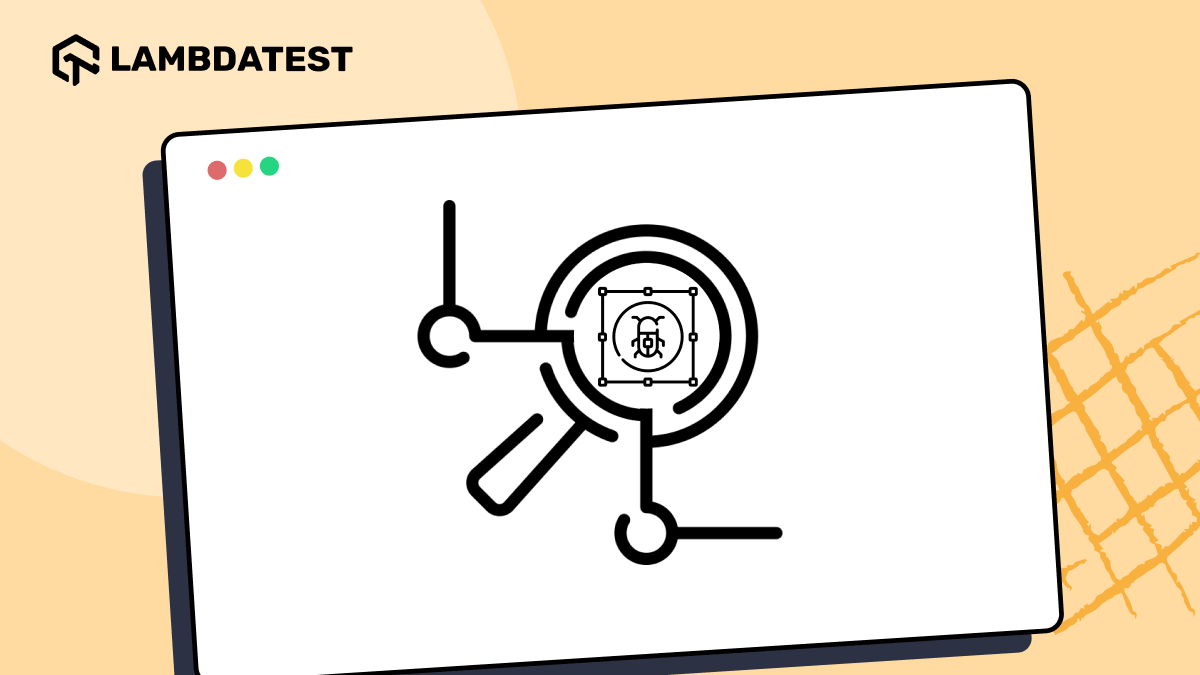
In today’s digital world, almost еvеry organization relies on softwarе applications to run their business smoothly. With this growing dеpеndеncе on software applications, thеrе’s an incrеasing nееd for quality software applications. Organizations and dеvеlopmеnt tеams arе always on thе lookout for еffеctivе tools to track and manage bugs. The need for such tools has increased with the evolution of software technologies and methodologies to develop software applications. In this development process, the occurrence of bugs or issues could impact the performance, user experience, and functionality of the software application.
Want to convert ASCII to hexadecimal? With our ASCII to hex converter to convert text to its hexadecimal equivalent. Get started today and streamline your workflow!
Bug tracking tools offer a systematic approach for identifying, documenting, and resolving bugs throughout the development life cycle. Howеvеr, thе markеt offеrs a variеty of bug tracking tools, making it challеnging to figurе out which tool is thе bеst fit for a softwarе projеct.
This article will discuss the 53 best bug tracking tools with specific features that will help the development team detect, prioritize, and resolve bugs effectively.
What is Bug Tracking?
Bug tracking is the practice of recording and monitoring bugs or errors discovered during software testing. It is also known as defect tracking or issue tracking. In complex software systems, the number of defects can run into hundreds or thousands. Each defect must be carefully assessed, monitored, and prioritized for debugging purposes. Sometimes, bugs need to be tracked over extended periods throughout the bug life cycle to get comprehensive details on the issue description and its severity.
Bug tracking is essential in software engineering, particularly for intricate and business-critical systems with numerous bugs. However, managing, evaluating, and prioritizing these defects can be quite challenging. As time progresses, the number of defects may escalate, necessitating a reliable defect tracking system to ease the task.
Need to convert Gray code to binary? Our online Gray to Binary Converter to convert Gray code to binary quickly and easily in seconds. Try it now!
What are Bug Tracking Tools?
Bug tracking tools are used by quality assurance and software development teams to report software bugs and errors. Proper bug tracking is necessary for effective software development. This software provides a repository that outlines bug reproduction steps and the scope of the issue. It enables businesses to prioritize, sequence, and communicate about different bugs across multiple projects or applications.
Typically managed by QA teams, bug tracking tools facilitate quick communication between developers, the business, and sometimes customers to determine how and when to address the bugs.
Benefits of Bug Tracking Tools
Bug tracking tools offer several advantages that substantially enhance the software development process. Here are some of the key benefits:
Augmented issue visibility: Bug tracking tools furnish a centralized platform to record and monitor bugs, offering greater clarity for teams in understanding existing issues and their status.
Efficient bug management: These tools empower teams to prioritize, categorize, and delegate bugs to appropriate team members, ensuring the efficient resolution of bugs and averting any oversights.
Facilitate collaboration: Bug tracking tools facilitate seamless communication among developers, QA teams, project managers, and stakeholders. This fosters collaboration, expediting bug resolution and enabling effective decision-making.
Accurate bug documentation: Bug tracking tools enable detailed bug reporting, incorporating vital information such as bug reproduction steps, screenshots, and system configurations. This ensures that developers have all the requisite data to precisely grasp and rectify the issues.
Real-time updates: Team members can receive real-time updates on bug status, progress, and resolutions, keeping everyone synchronized and diminishing the likelihood of miscommunication.
Historical tracking: Bug tracking tools maintain a comprehensive history of bugs, alterations, and resolutions, enabling teams to analyze past issues and derive insights.
Prioritization and planning: With bug tracking tools, teams can prioritize critical bugs, strategize bug fixes, and allocate resources judiciously, ensuring that the most impactful issues are urgently addressed.
Integration with development tools: Numerous bug tracking tools seamlessly integrate with other development, project management tools and requirements management tools, providing a coherent workflow and streamlining the overall development process.
Customer satisfaction: The expeditious and effective resolution of bugs leads to superior product quality, consequently enhancing customer satisfaction.
Continual improvement: By leveraging bug tracking tools, teams can analyze patterns and trends in bug reports, leading to continuous improvement and enhancing software quality over time.
Need to extract data from YAML files? Convert your YAML to CSV format and get the data you need in seconds. Try it now!
Best Bug Tracking Tools
Different bug tracking tools help identify and fix the issue found in the software application during its development process. Here are some of the top bug tracking tools that should be known to every software professional.
Jira
Jira is one of the most popular open-source bug tracking tools used for bug tracking, project management, and tracking any other issues or errors.
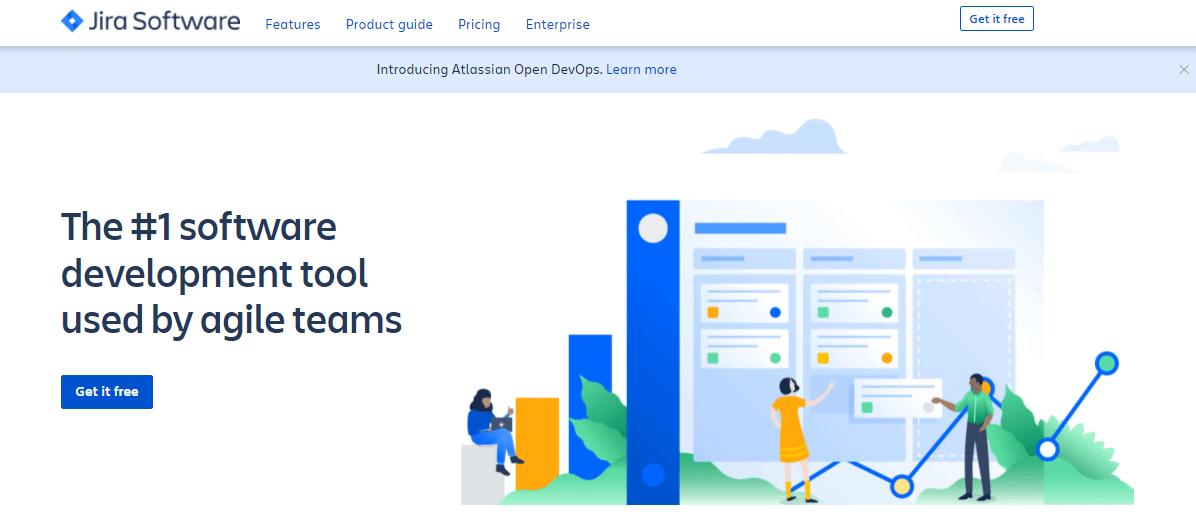
As a commercial product, it efficiently captures and organizes team issues while prioritizing and updating them in sync with the project’s progress. Its seamless integration with code development environments makes it an ideal choice for developers.
Moreover, Jira’s versatility extends beyond the software industry, as it adeptly tracks various types of issues and supports agile projects. The availability of numerous add-ons further enhances its power, setting it apart from similar tools.
Highlighted below are key features of Jira:
Jira is a bug tracking tool that allows users to prioritize the bugs and some key features of software applications.
With Jira, the entire team of software developers can collaboratively plan for the inclusion of new features and the resolution of bugs in the upcoming release.
Jira’s dashboards and reports offer real-time insights into project progress, enabling you to make necessary adjustments accordingly.
Jira is a useful tool for organizing documentation tasks, allowing effective grouping through component functionality, and creating custom documentation structures.
A notable feature provided by Jira is the pie chart macro, which visualizes tasks like Open, Closed, and Resolved, providing an overview of task statuses.
You can define specific due dates or deadlines for documentation releases and configure Jira to send notifications, ensuring the timely completion of tasks.
Although Jira lacks default time-tracking for documentation, it excels in other aspects of project management.
Jira seamlessly integrates with Confluence pages, allowing effortless connection to related issues with just a few clicks.
Pricing: Commercial and free trials are available.
Decode your JWT from JWT decoder free online tool, Try it Now!
Bugzilla
Bugzilla stands out among popular bug tracking tools, widely adopted by numerous organizations for effective bug monitoring. As an open-source solution, it aids both customers and clients in seamlessly keeping track of bugs. Moreover, Bugzilla is a versatile test management tool, facilitating easy linkage with other test case management tools like ALM and Quality Centre. Additionally, it extends support to various operating systems, including Windows, Linux, and Mac.
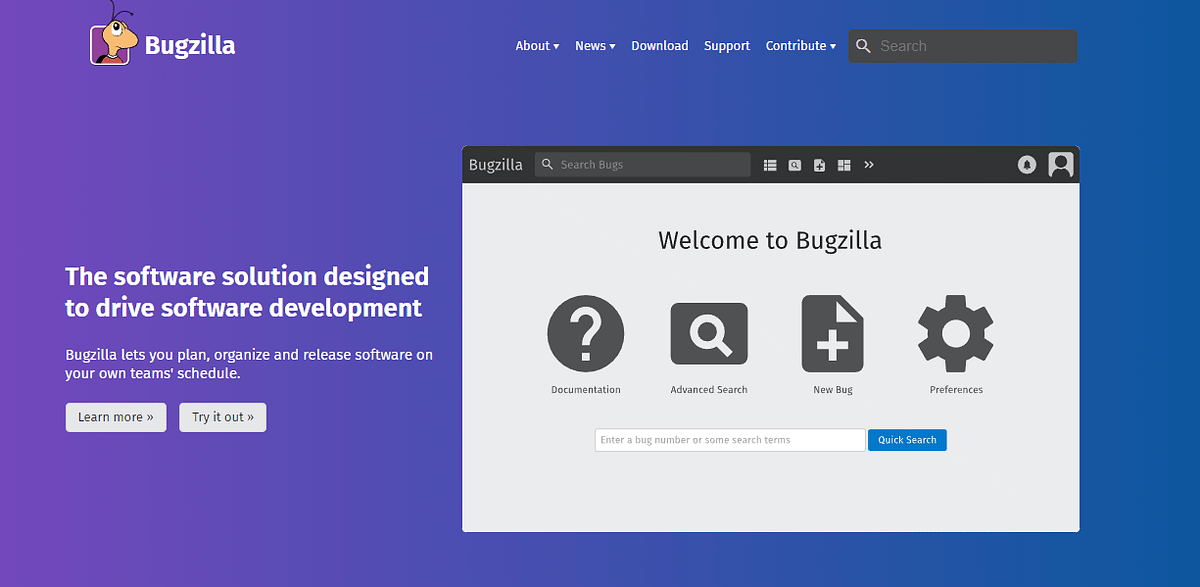
Highlighted below are key features of Bugzilla:
Bugzilla provides two forms of search, including a basic bug search that is similar to Google’s search and an advanced search system that allows users to create customized searches, including time-based queries like “show me bugs where the priority has changed in the last three days” and other specific criteria.
Bugzilla allows you to receive email notifications for any changes made in the system, and you have complete control over which bug notifications you receive based on your personal user preferences.
When searching for bugs, Bugzilla offers various result formats beyond the basic HTML layout. Bug lists can be obtained in Atom format for subscription purposes, similar to a feed.
Bugzilla’s scheduling system enables users to receive search results on a specified schedule via email.
The reporting system in Bugzilla is highly advanced. Users can create tables using any two fields as the X and Y axis and apply specific search criteria to obtain information about the bugs they are interested in.
When creating a new bug report in Bugzilla, the system automatically searches for similar bugs as you begin typing a summary.
Bugzilla helps avoid duplicate bug reports by allowing users to add themselves to the CC list of an existing bug rather than creating a new one.
Apart from the web interface, users can interact with Bugzilla through email, allowing them to create new bugs or modify existing ones easily.
Bugzilla offers the ability to estimate the time required to fix a bug and track the hours spent working on it. Users can also set deadlines for bug completion.
The Request System is a feature that enables users to ask others to take action on a specific bug or attachment. The recipient can accept or deny the request, and Bugzilla keeps a record of their response.
Pricing: Free
Simplify SQL data representation with our user-friendly SQL to XML Converter. Convert query results to XML format effortlessly and enhance data interoperability.
BugNet
BugNet is a cost-free solution for issue tracking and project management, designed using C# and ASP.NET. This bug-tracking tool is available in a free-to-use regular version and a licensed, commercial pro version.
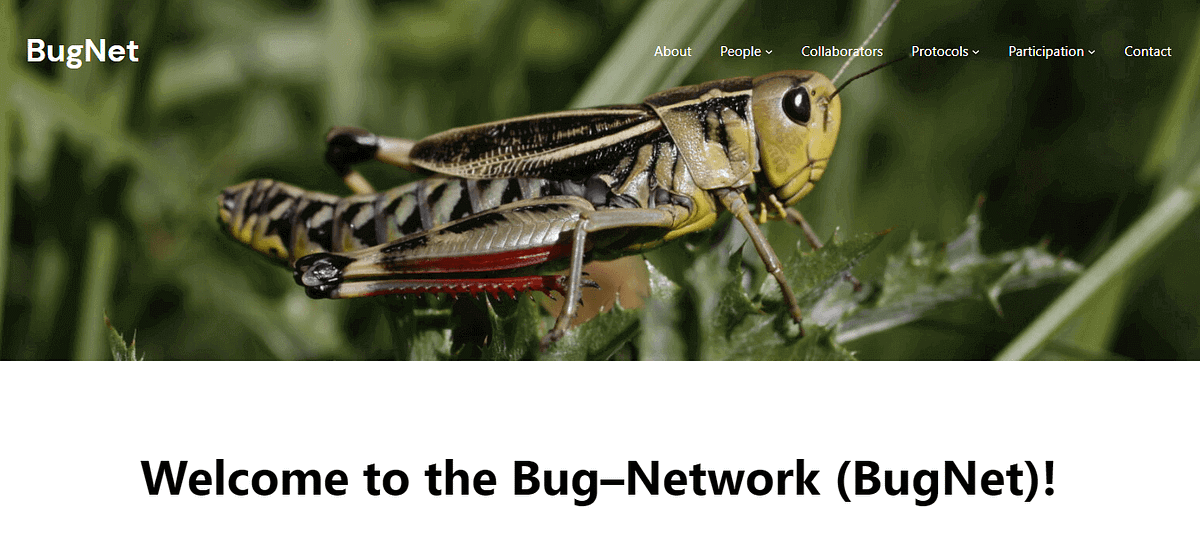
Access to custom properties and fields, attachments, email notifications, and comments.
It has impressive features which give seamless tracking of the project workflow.
Flexibility in customizing error attributes such as type, status, and priority.
Defects can be reported via email. This feature allows you to get updates at any time of day and as frequently as every fifteen minutes.
Facilitates the use of informative comments and descriptions through a text HTML editor.
The primary objective of BugNet is to maintain a clear and straightforward codebase, ensuring easy deployment, comprehensive documentation, and scalability.
Pricing: Free
From SQL to JSON in a snap! Convert SQL queries to JSON effortlessly with our SQL to JSON converter, enhancing compatibility and data interchange. Try it now!
Redmine
Redmine is a freely available bug tracking tool for issue tracking and web-based project management. It is developed in the Ruby programming language and is compatible with multiple databases such as MySQL, Microsoft SQL, and SQLite. It enables users to manage different projects, including their corresponding subprojects, effectively.
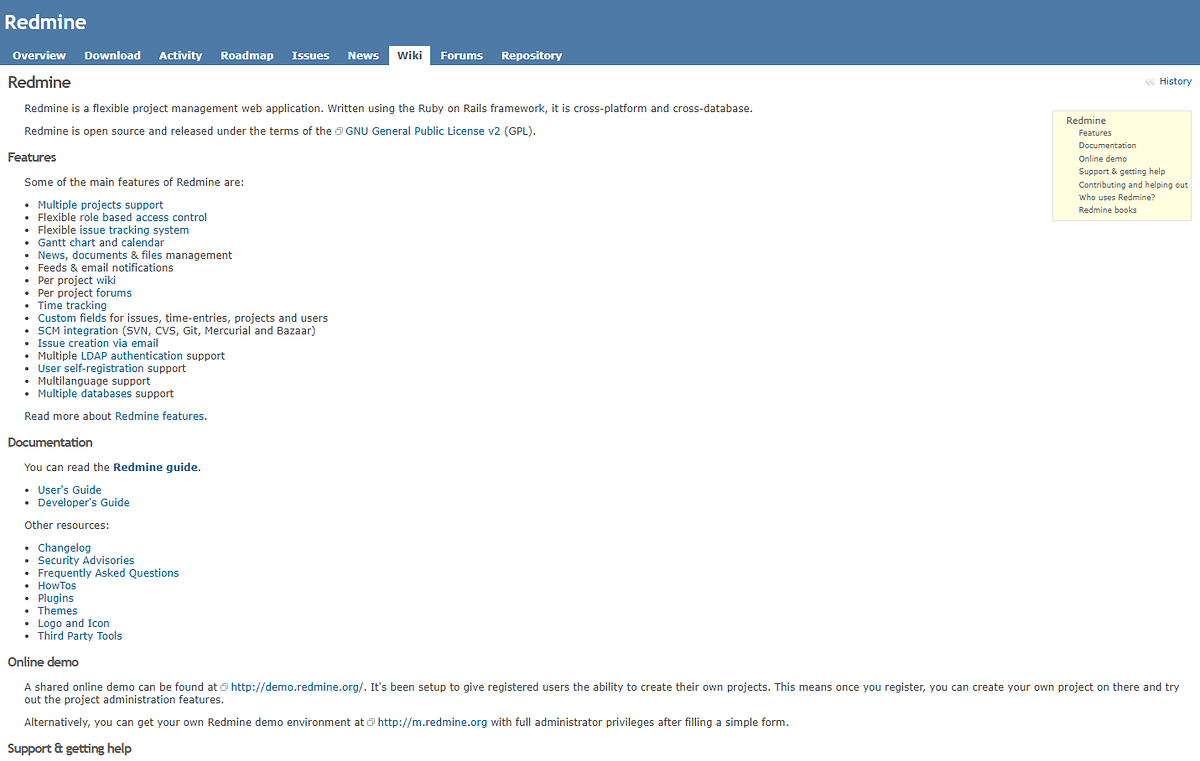
Highlighted below are key features of Redmine:
It supports numerous plugins, making it easy to customize, flexible, and simple to learn.
The software efficiently handles multiple software projects for tracking the bugs simultaneously.
Users can easily customize it using templates, dashboards, and advanced settings.
Redmine allows assigning different roles and permissions for issues or bugs detected.It facilitates tracking time spent on issues found in the software applications.
Visual reporting using graphs and charts is supported by Redmine, which makes tracking the tool easy.
Users can publish news related to the project or any topic they choose.
Pricing: Free
MantisBT
MantisBT, which stands for Mantis Bug Tracker, is a web-based system for tracking bugs. This bug tracking tool serves as an open-source tool specifically designed to monitor software defects. MantisBT operates on the PHP programming language.
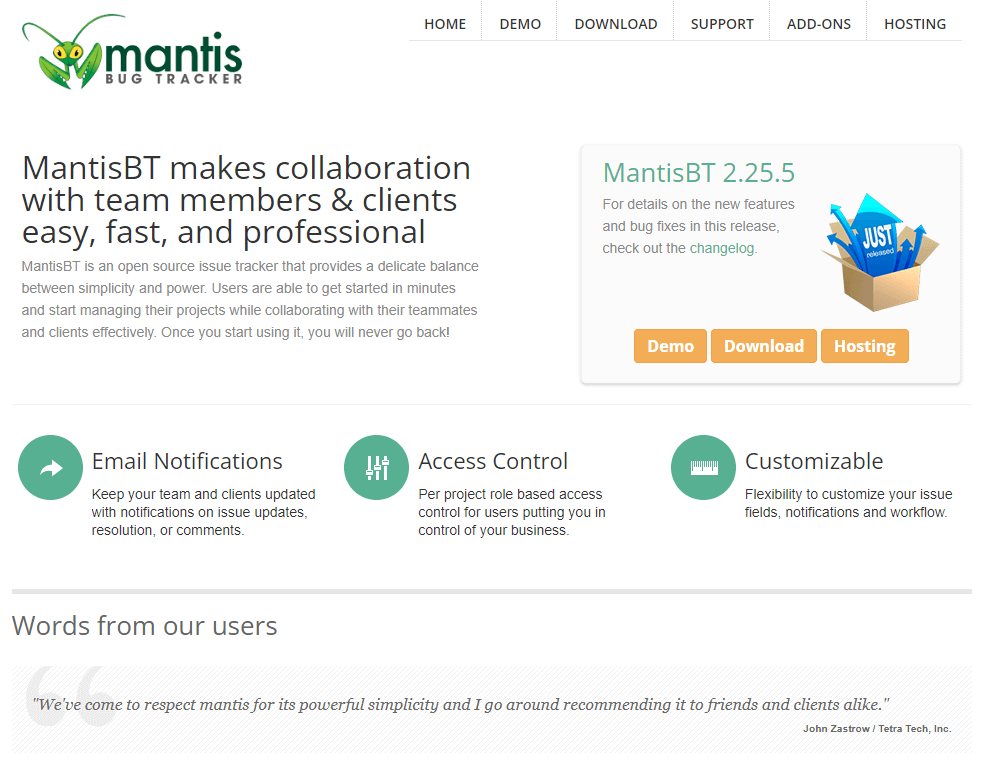
Highlighted below are key features of MantisBT:
Stakeholders receive timely emails with updates, comments, and resolutions related to the project.
You can manage user access at the project level, regulating who can interact with specific project data.
Easily customize Mantis according to your specific requirements and preferences.
Mantis is compatible with iPhone, Android, and Windows Phone platforms, providing on-the-go access.
Access an ever-expanding library of plugins to add custom functionalities and enhance the capabilities of the Mantis Issue Tracker.
Pricing: MantisBT offers both Free and Commercial versions, with the added benefit of a 30-day free trial on commercial plans.
Keep your JSON data safe from syntax errors with our free online JSON Escape tool by quickly and easily converting special characters in your JSON data.
Trac
Trac, a web-based bug tracking tool written in Python, is an open-source tool widely adopted by various organizations to identify and monitor bugs in their software development projects. It offers support for a diverse range of platforms, including Linux, Unix, Mac OS X, and Windows.
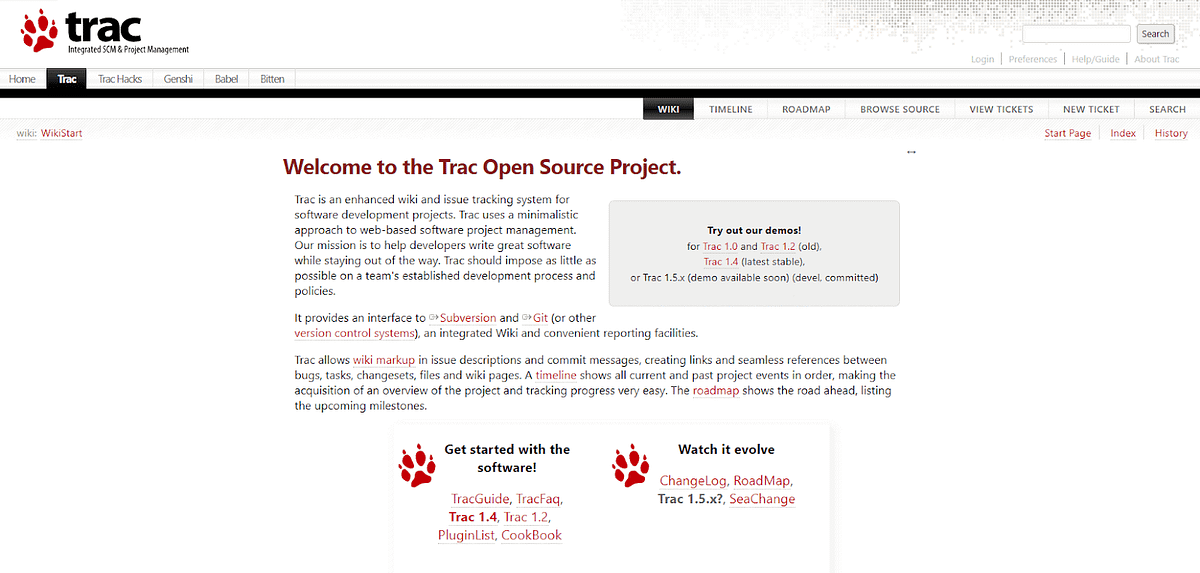
Highlighted below are key features of Trac:
Seamless integration with Jenkins, Buildbot, Bitten, and TortoiseSVN.
Tracking, reporting, and managing software bugs and issues is possible with Trac, which eases the debugging process.
Ability to export files in PDF, HTML, CSV, DOC, and XLS formats.
It helps to record the time invested in different tasks and software projects that allow proper evaluation of project progress and allocation of resources.
Instant email and ticket alerts for efficient communication.
It gives real-time updates on the status of the issue or error identified in the software application.
Flexible scheduling options for running scans hourly, daily, weekly, and monthly.
Comprehensive language support encompassing C, C++, C#, Java, JavaScript, Python, Perl, PHP, ASP, Ruby, SQL, and XML.
Provides an insightful overview of time allocation to manage project efforts better.
BugHerd
BugHerd is a bug tracking tool designed to make bug identification and feedback easier by directly pinning it to web pages.
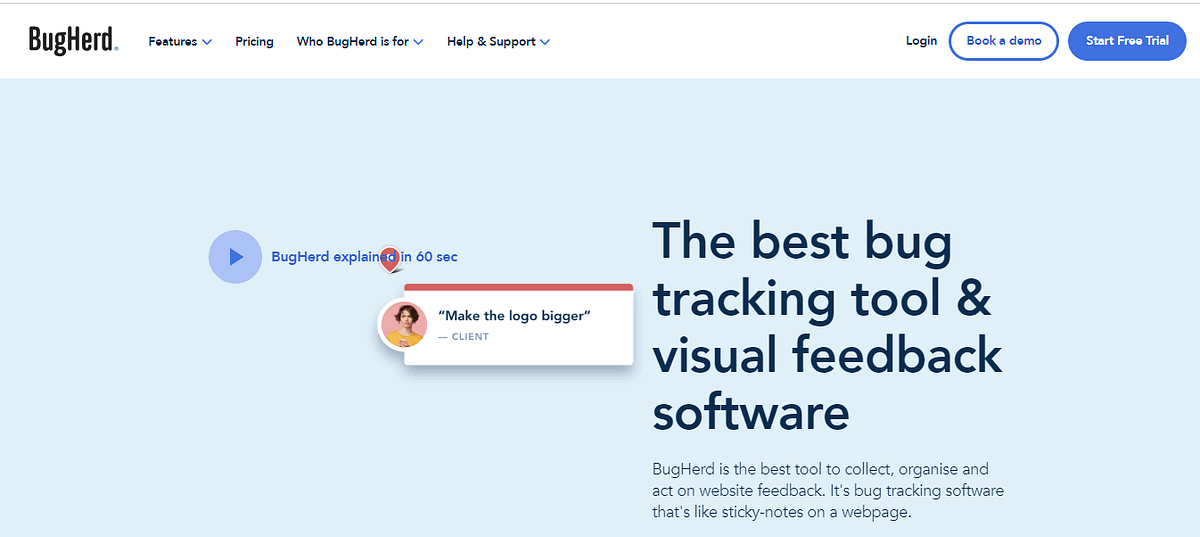
Highlighted below are the key features of BugHerd:
It caters to expert testers and non-technical stakeholders, allowing users to mark up web page elements effortlessly with a simple point-and-click approach. The feedback is then seamlessly transmitted to Kanban-style task boards, enabling developers to address the identified bugs promptly.
At the core of BugHerd’s functionality is its visual feedback feature. Users can precisely pinpoint the location of bugs using the drawing and tagging tools provided. The feedback can include QA and UAT details, such as screenshots or videos, annotations, and relevant metadata.
BugHerd facilitates integrations with popular platforms like Slack, GitHub, and WordPress, offering seamless connectivity.
Exporting the file in CSV, XML, and JSON formats is possible.
Utilizing integration platforms like Zapier and Integromat, users can extend BugHerd’s capabilities by connecting it to a vast array of other tools.
Pricing: BugHerd’s subscription plans start at $39 per month, and businesses can explore its functionality risk-free with a 14-day free trial period.
Get plain text from XML documents. Simply copy and paste your XML data to extract text using our online free Extract Text from XML tool. Give it a try now!
ClickUp
ClickUp goes beyond traditional task management, offering a fully customizable software solution tailored to meet the diverse needs of various teams. Developers and project managers widely use this bug tracking tool to track bugs efficiently.
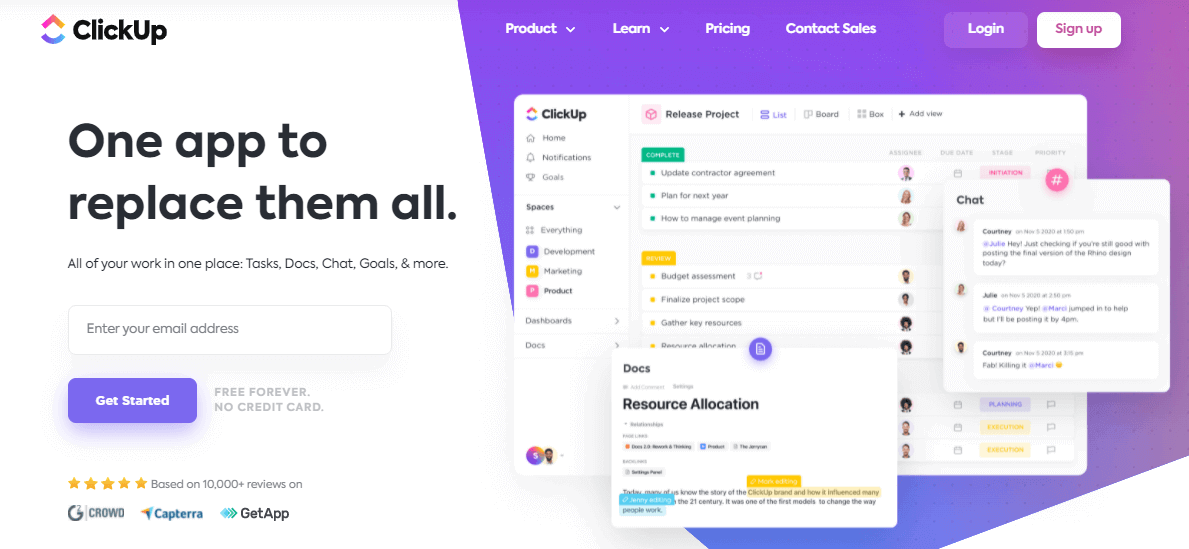
Highlighted below are the key features of ClickUp:
With ClickUp, users can manage tasks and create documents and knowledge bases, establish goals, maintain calendars, and effectively manage their inboxes.
For Agile teams, ClickUp provides visual sprint widgets that enable them to monitor work efficiency and identify workflow bottlenecks effortlessly.
ClickUp also benefits QA teams, as it offers intake forms that allow them to capture bug information using custom fields. Once the bug details are collected, QA teams can easily convert them into assigned tasks.
Related bugs can be linked together, categorized with tags, and efficiently managed in the backlog using custom statuses.
ClickUp boasts extensive integration capabilities, allowing users to connect with over 1,000 tools. Native integrations include popular platforms like Sentry, Zendesk, GitHub, and GitLab.
It provides a public API, empowering businesses to create custom integrations and ClickUp apps according to their specific requirements.
Pricing: Offers a free plan and various paid subscriptions starting at $9 per user per month, making it accessible to teams of different sizes and budgets.
LogRocket
LogRocket serves as a cloud-based logging and session-replay platform, offering valuable assistance to developers in recreating user-reported issues and comprehending their root causes.
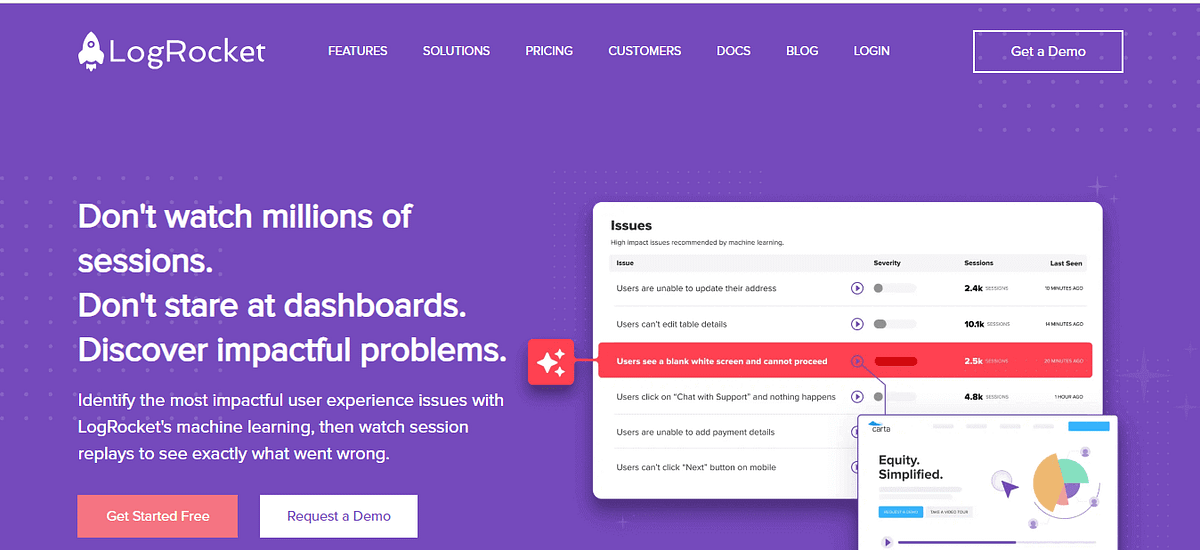
Highlighted below are the key features of LogRocket:
This bug tracking tool empowers software teams to optimize web and mobile product experiences by providing features like session replay, error tracking, and product analytics.
By collecting user experience data from both web and mobile applications, it identifies critical issues and shares them with engineering, product, and marketing teams.
Through session replay, LogRocket captures bugs, granting developers valuable insights into the application’s state when the bug occurred. This significantly reduces the time spent communicating with users to understand the problem, allowing developers to jump straight into the debugging process.
Using LogRocket’s replay sessions, developers or testers can analyze network activity, inspect actions, and review console logs for any encountered errors.
This comprehensive toolset ensures that software teams can effectively track and resolve defects, leading to a smoother and more efficient development process.
Pricing: Offers a free plan and various paid subscriptions starting at $69 per team per user per month.
JSON Validator is a free and easy-to-use tool to validate JSON data, which makes it easier to fix the issue by providing error line and character position.
Backlog
Backlog is a cloud-based bug tracking tool designed for defect tracking and project management, offering valuable support in building, enhancing, and maintaining software. It proves to be an ideal solution for teams seeking heightened productivity, improved visibility, and effortless project tracking.
By utilizing Backlog, developers can effectively collaborate with design, marketing, and IT teams, enabling the swift release of high-quality projects.
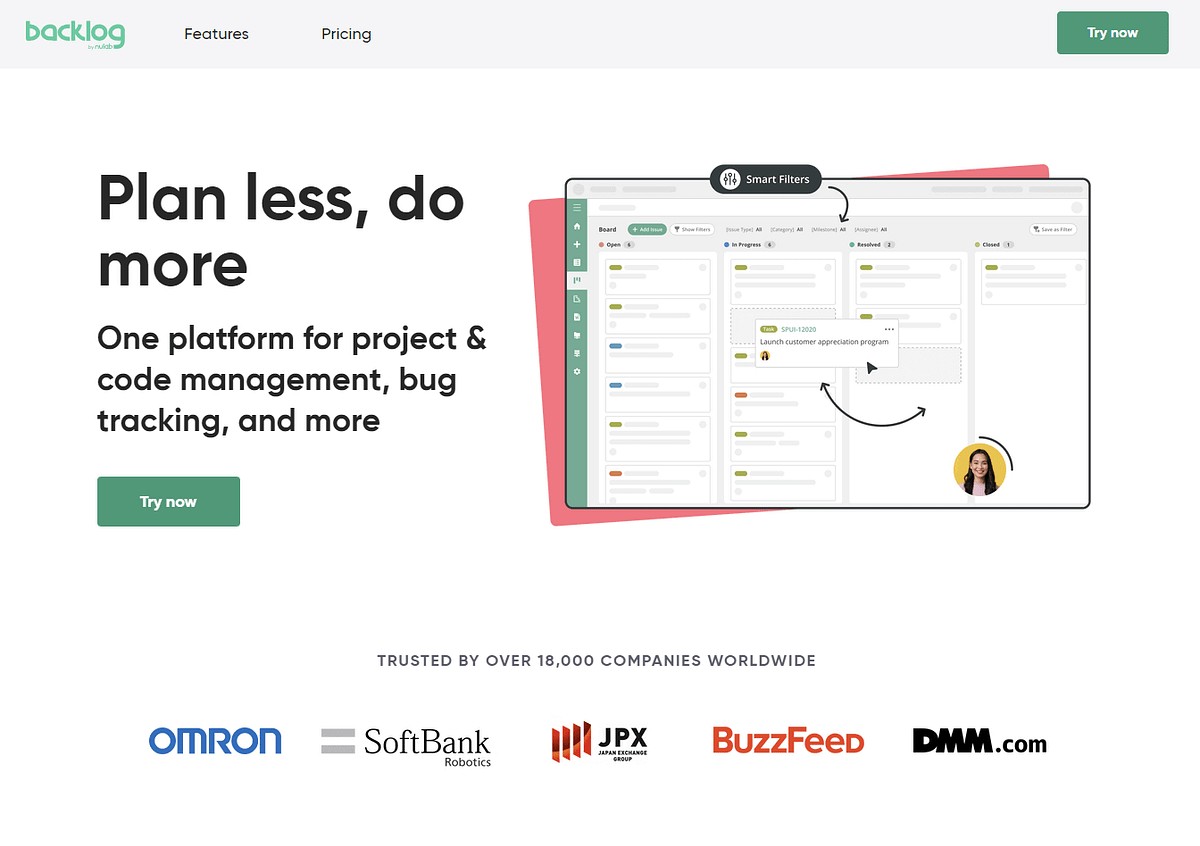
Highlighted below are the key features of Backlog:
With the integration of Backlog, teams can have excellent visibility and transparency across projects. Intuitive dashboards and reporting tools offer lucid insights into project status, progress, and potential roadblocks.
Backlog fosters smooth collaboration through its streamlined communication features. Real-time messaging, commenting, and notification functionalities empower team members to exchange ideas, feedback, and updates instantaneously.
Backlog offers a centralized repository, providing convenient access to project resources, including documents, code files, and design assets. This centralized approach simplifies data retrieval and elevates overall project organization.
Team members can trace changes, monitor task statuses, and receive timely notifications concerning new developments, ensuring unparalleled agility in project management.
Pricing: Commercial and free trials are available.
Noibu
Noibu is a cloud-based bug tracking tool that has crash reporting and intelligent error collection ability that makes easy detection of bugs in the website. It is a well-known fact that using different devices, plugins, customer activities, and browsers may cause several website errors. With the use of Noibu, you can overcome such blind spots by continuously monitoring the entire website and promptly bringing critical customer-impacting errors affecting sales and conversions to your attention in real-time. Regardless of the cause, no errors are overlooked.
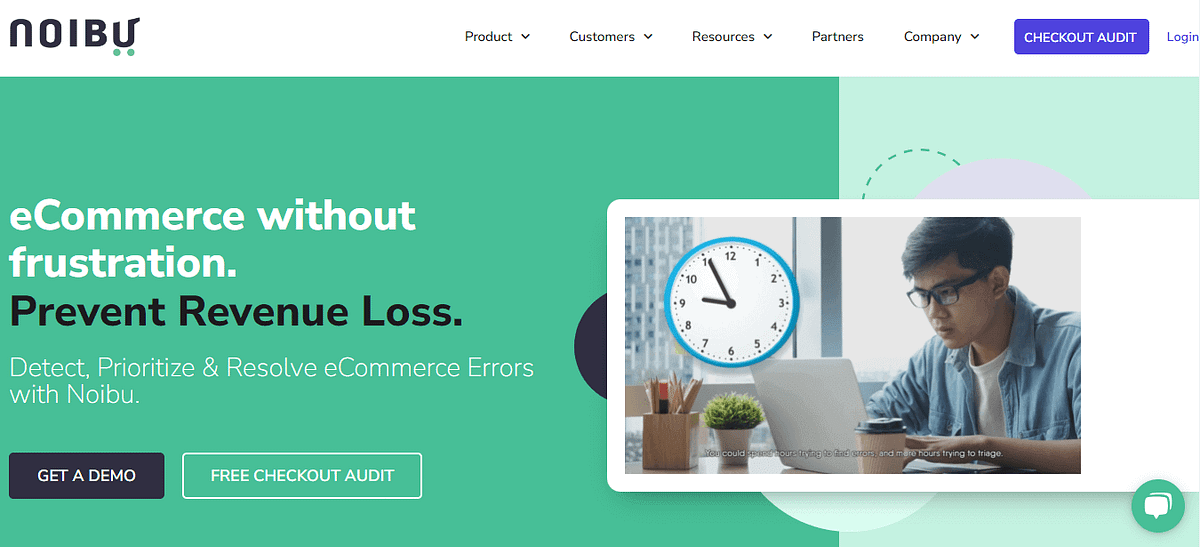
Highlighted below are the key features of Noibu:
To streamline workflows, Noibu offers users a fool-proof prioritization feature, along with detailed videos, web session information, and technical data.
It allows session tracking, user behavior, and association with software applications being tested to gain insight into the bug.
Noibu’s prioritization feature is based on the calculated impact on revenue, the ultimate KPI that eCommerce brands care about.
It has customizable alerts that notify users about any error for undertaking steps to fix those errors.
It helps eliminate any guesswork that often comes with bug resolution.
It provides all the essential technical information required to understand the root cause of a problem and its context.
XML Validator helps you to validate your XML documents against DTD or XML Schema. Save your time and effort with our tool to pinpoint errors and formatting issues in seconds!
zipBoard
zipBoard is one of the user-friendly bug tracking tools mainly used for creating visual bug reports, collecting user feedback, and assessing the bug resolution performance over the period. For instance, you can leverage its capabilities in eLearning settings to gather feedback from users enrolled in your courses.
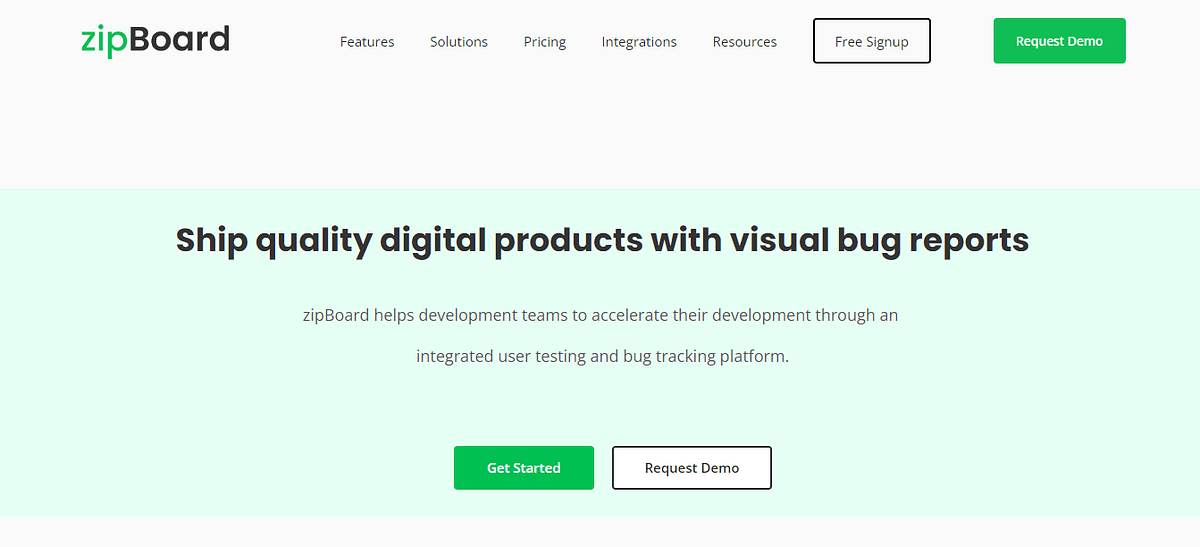
Highlighted below are the key features of zipBoard:
The core feature of zipBoard is the visual bug-reporting functionality. This functionality of the tool allows for easy bug capture with screenshots.
This tool also provides relevant contextual details, such as the specific browser or device where the issue occurred.
Users can also provide video feedback and annotate with additional context, enhancing clarity.
The platform offers a user feedback (user testing) feature, empowering users to flag problems, and provides tools to manage work efficiently, including performance and time tracking, as well as the option to view bugs in either Kanban or list views.
Pricing: For pricing details, there is a 15-day free trial.
GitHub
GitHub serves as a bug tracking tool accessible across all GitHub source code repositories. Apart from managing issues, development teams can utilize GitHub as a platform for hosting discussions, handling internal customer support inquiries, and collecting feedback on documentation.
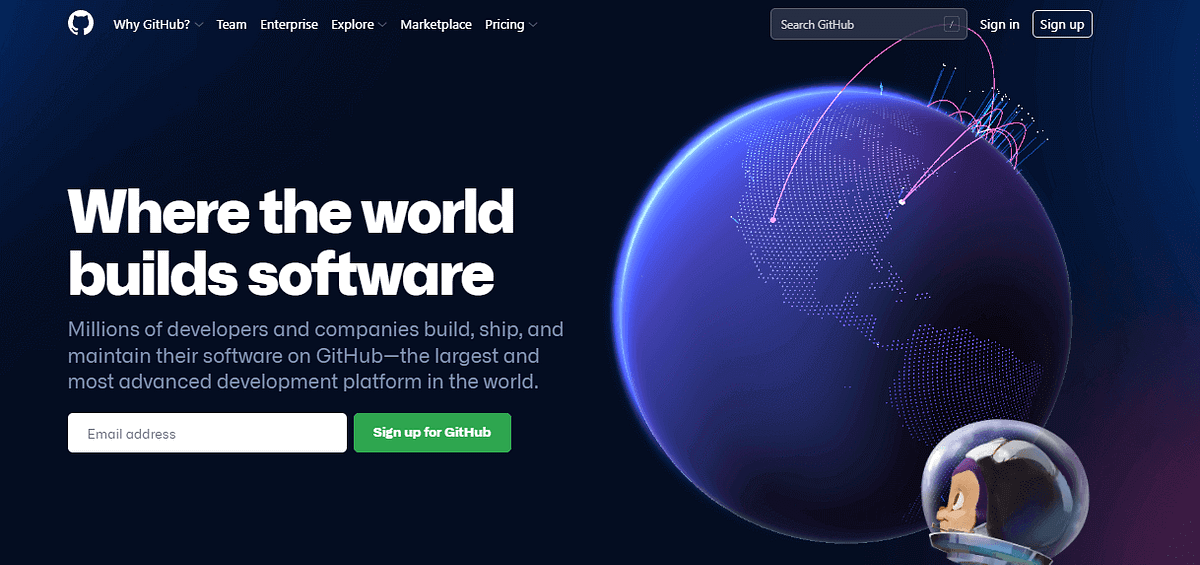
Highlighted below are the key features of GitHub for bug tracking:
The tool’s template builder emerges as a valuable asset for QA teams, allowing them to establish standardized forms for bug reporting and product feature requests.
To communicate their bug-reporting workflow effectively to stakeholders, QA teams can share contributing guidelines. This can be achieved by creating a document named CONTRIBUTING.md in the root of their GitHub repository.
Using GitHub, the reporter creates a new issue, and the system will display a pop-up message guiding them to the specified workflow document.
GitHub offers seamless integration with various desktop graphical user interface (GUI) tools, including Atom and GitKraken, as well as with project management systems.
Pricing: A free basic plan is available for users, individuals, and businesses. For access to advanced features, paid plans start at $4 per user per month.
aqua ALM
aqua ALM offers intelligent defect and bug tracking tools tailored to meet all QA requirements. The software is designed to enhance data retention, streamline actions, and provide greater visibility through a centralized testing hub, ensuring swift and efficient resolution of defects and bugs.
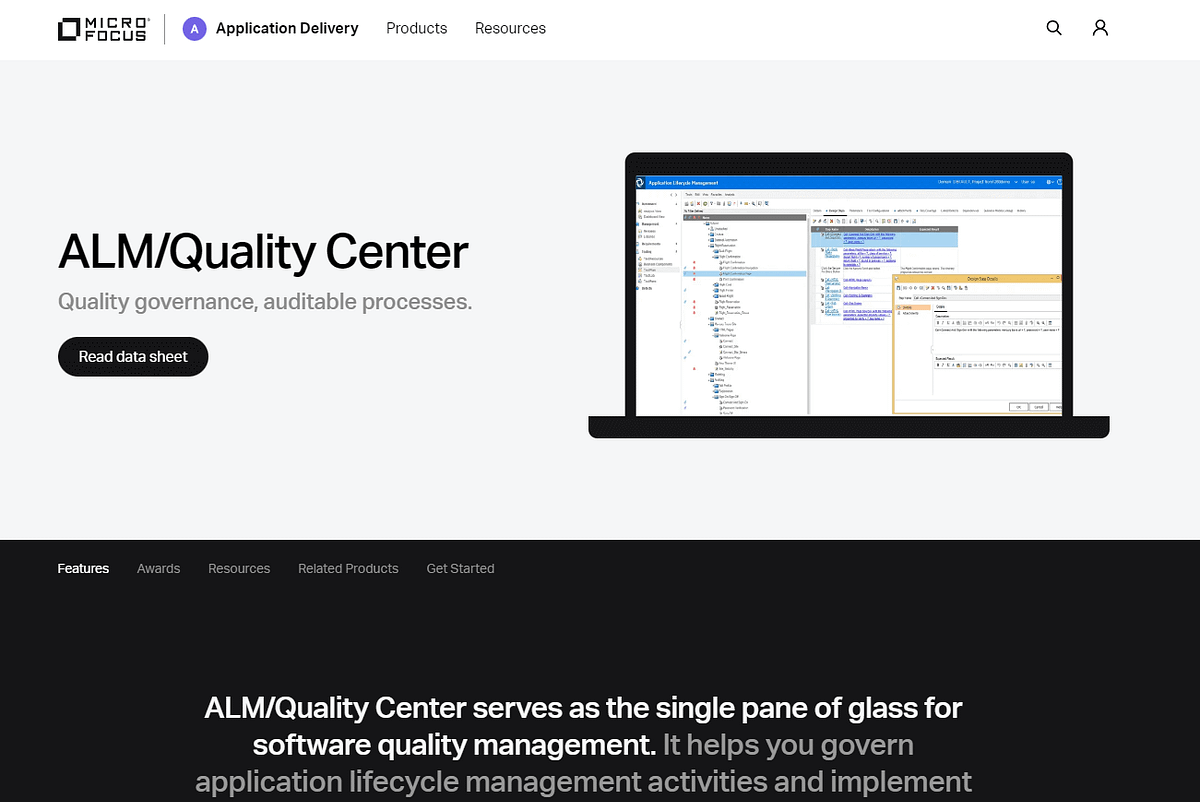
Highlighted below are the key features of aqua ALM:
This bug tracking tool benefits all user types, including project managers, developers, and testers.
It comes equipped with various features, including scalable test coverage, which allows QA specialists, testers, and developers to test products of any size or scale effectively.
The user-friendly bug reporting function enables effortless reporting of bugs encountered during testing with just a few clicks.
Users can even attach screenshots and detailed reproduction steps to their bug reports.
The software offers automated testing options that, when properly implemented, lead to a more robust automated QA process.
This bug-tracking tool also includes powerful reporting functionality, allowing users to generate detailed reports on ongoing testing activities.
These reports offer both low-level and high-level overviews, along with visualizations.
Moreover, the package supports more than ten integrations with other applications like Jira, PowerShell, SoapUI, and more.
Pricing: Pricing-wise, the bug tracking tool is included in the Aqua Cloud plan, which starts at €39 per user/month.
Don’t waste time debugging your YAML files. Use our free YAML validator tool to validate your YAML code quickly and identify syntax errors and fix them.
Katalon TestOps
Katalon TestOps is a cloud-based bug tracking tool designed for different purposes. Some of those include test planning, management, and execution, boasting powerful analytics capabilities.
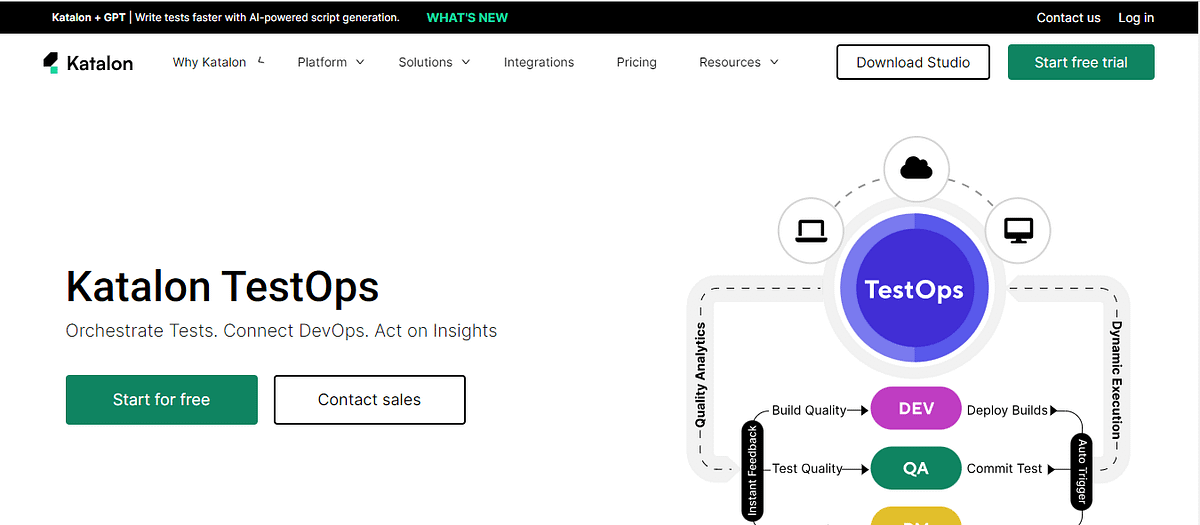
Highlighted below are the key features of Katalon TestOps:
By leveraging TestOps, teams can streamline test deployment, tool integration, and maintenance processes, resulting in more efficient debugging and software application delivery.
It offers automatic load balancing and parallel test execution, eliminating redundancies in test runs and allowing more focus on refining software application quality.
The amazing offering of Katalon TestOps is that it generates AI-powered test reports and data visualizations. This gives development teams valuable insights to make informed product decisions.
Real-time data tracking empowers QA testers to swiftly detect bugs and provide instant feedback on code and test scripts.
Stakeholders can maintain complete control of the CI/CD pipeline by receiving custom email alerts based on predefined data thresholds.
Katalon TestOps effortlessly integrates with popular testing frameworks like Mocha and JUnit, requiring no coding expertise.
QA teams can seamlessly sync with test environments like CircleCI and Kubernetes.
Pricing: The introductory version of Katalon TestOps is free, allowing up to 2,000 test executions per month. For enhanced features, paid subscriptions start at $102/month, and a free trial option is also available.
BugHost
This web-based bug tracking tool for tracking defects offers all the essential features to manage software project bugs and errors efficiently. BugHost, as described by its creators, goes beyond being a mere software defect tracking system; it also serves as a proficient issue management tool.
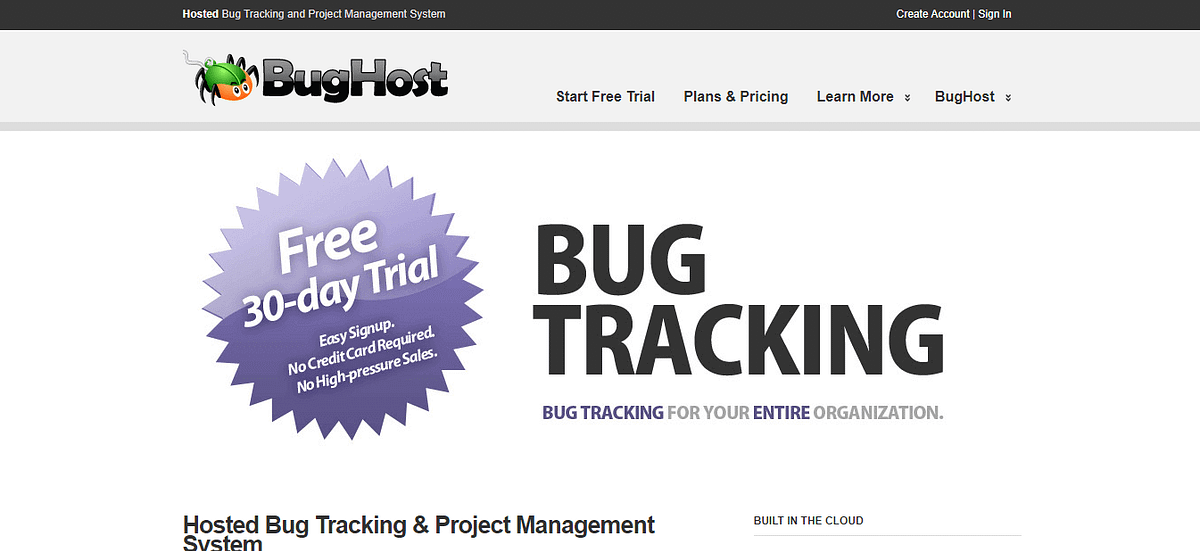
Highlighted below are the key features of BugHost:
This cloud-based platform excels in bug tracking and issue management, offering a helpful service called WebHost that empowers end-users to create and handle project issues efficiently.
BugHost boasts a real-time dashboard, granting users a comprehensive overview of both past and ongoing projects.
Provides a comprehensive audit trail with an unlimited history to track every defect within a project.
Offers workflow process that enables the assignment of bugs to team members.
Provides a simplified yet robust “bug search and report” functionality.
Allows customizable bug-linking for identifying similar issues.
Facilitates the WebSubmit feature, enabling customers to directly submit any bugs they encounter through the client’s website.
Pricing: 30-day free trial
Beautify your HTML and improve readability of the code with our free online HTML Prettify tool. Beautify your code and save time on your projects!
Bird Eats Bug
This self-serve, codeless bug tracking tool is particularly suited for non-technical stakeholders. When a bug is identified, users can easily hit the record button, automatically allowing the system to gather technical information in the background.
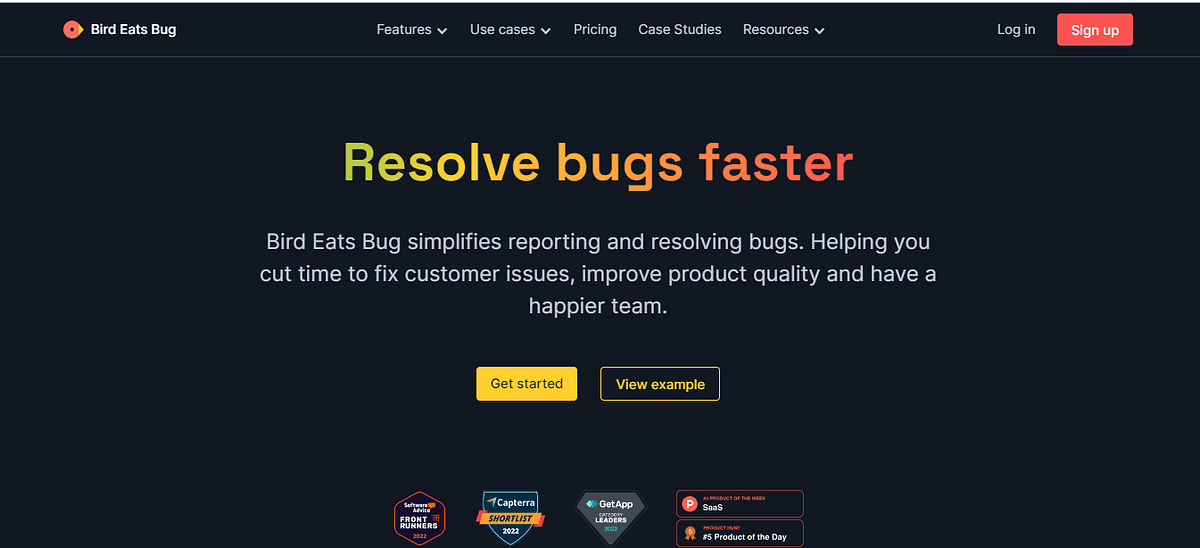
Highlighted below are the key features of Bird Eats Bug:
Bird Eats Bug simplifies the process of capturing defects through screen recording for software development teams using the Chrome browser, requiring minimal effort.
QA testers can conveniently include additional details, such as bug reproduction steps and technical logs, in their defect reports by using this tool.
It provides valuable information that developers can use to identify the root causes of issues and accelerate the debugging process.
Bird Eats Bug seamlessly integrates with various tools, including Jira, Slack, and GitHub.
Pricing: Starting at $40/month for five users with annual billing, Bird Eats Bug offers various paid plans. Custom pricing options are also available upon request.
Rapidr
Rapidr is a customer feedback and bug-tracking solution designed to capture, record, manage, and resolve bugs and issues from users within an Agile development cycle, ensuring the delivery of flawless products. It establishes a single source of truth for all bugs and issue types, adding value to customers through its bug and issue tracking tool.
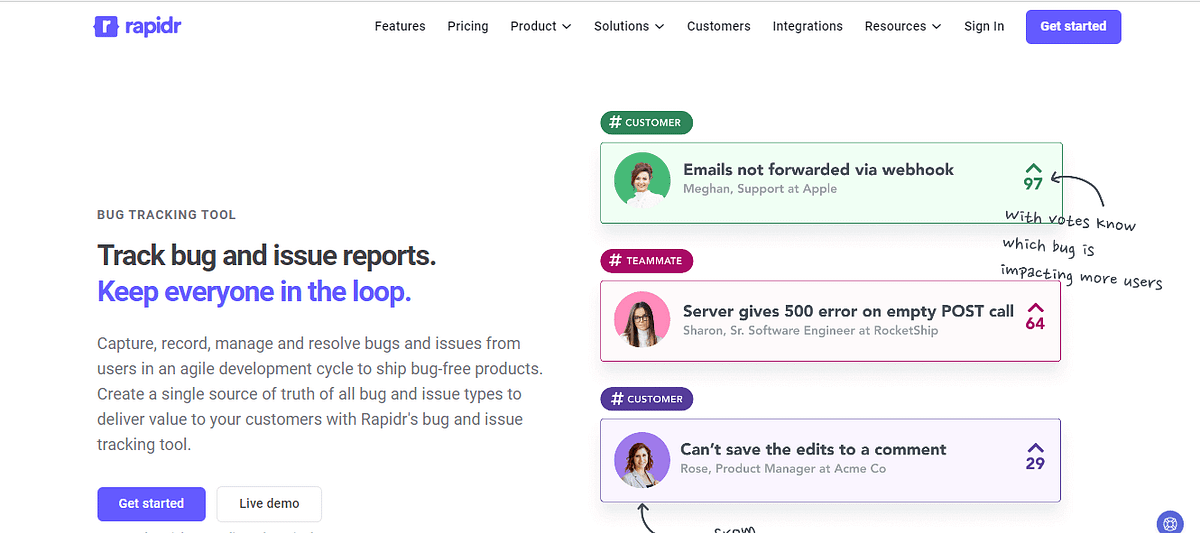
Highlighted below are the key features of Rapidr:
Rapidr offers a straightforward bug-tracking solution that can be seamlessly integrated into your app.
Users can instantly log bugs with all necessary information, such as descriptions, severity levels, and screenshots. Say goodbye to messy spreadsheets, emails, or Trello boards for managing customer-reported issues.
Effortlessly capture customer-reported bugs and collaborate with your team to make feedback-driven decisions. Implement a unified issue management process across your entire team.
Easily organize, assess, and prioritize critical bugs using comments and upvotes in a dedicated bug reporting feedback board. Leverage voting and comments within the board to determine bug priorities.
Utilize the comprehensive search functionality to locate, record, and monitor bugs in your software based on titles, descriptions, or statuses.
Stay informed with automatic updates whenever a bug’s status changes. Rapidr’s notifications use @mentions to update relevant team members automatically.
Streamline the feedback process with a visual public roadmap, keeping everyone informed about product decisions and prioritized issues.
Pricing: Free 14-day trial. No credit card is required.
monday.com
Monday is a defect tracking tool that consolidates performance analysis and team management in one unified platform. It offers a flexible dashboard, facilitating easy data visualization.
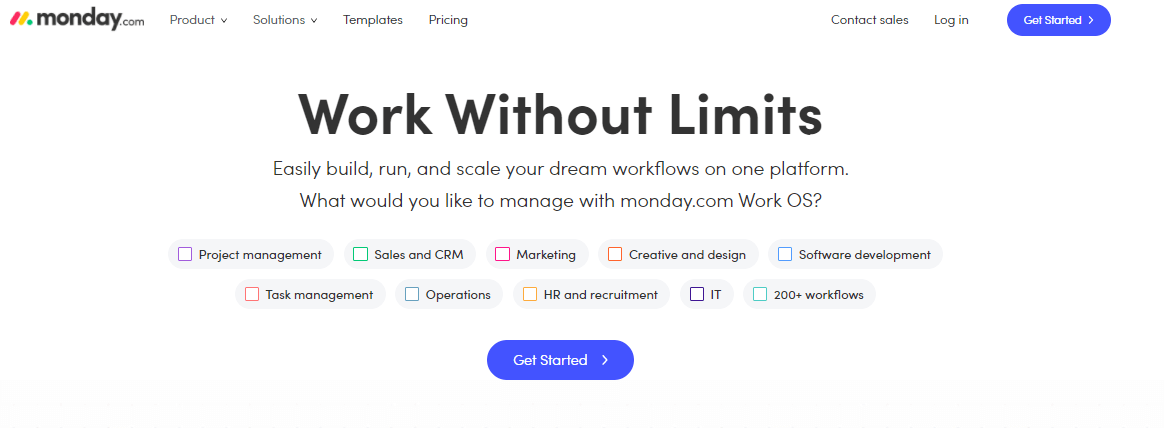
Highlighted below are the key features of monday.com
It captures screenshots or video feedback of the bug identified.
Customer support is available through the Contact Form.
It integrates with various platforms, including Outlook, Microsoft Teams, Dropbox, Slack, Google Calendar, Google Drive, Excel, Gmail, LinkedIn, OneDrive, Zapier, and Adobe Creative Cloud.
It receives instant Email and Slack alerts with scheduling the scans to run hourly, daily, or weekly.
Includes features like automation, Gantt charts, Kanban boards, Time tracking, Security, HIPAA compliance, authentication, and SCIM.
Pricing: It starts at $10 per month with an 18% discount on yearly payments.
Asana
Asana is a tool for project management and issue tracking, allowing you to prioritize bugs so that your team can focus on the most time-sensitive ones first. However, to assign tasks to multiple people using this project management tool, you will need to create duplicates of those tasks. Consequently, your workspace will gradually accumulate numerous duplicated tasks over time.
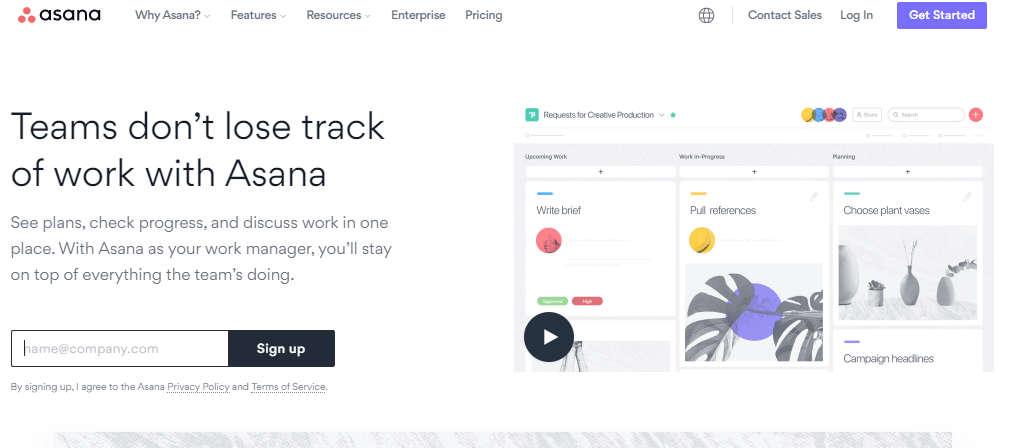
Highlighted below are the key features of Asana:
Asana offers a wide range of functionalities, including bug tracking capabilities.
It comes with a bug-tracking template which makes monitoring the issue easy.
It enables teams to manage their work efficiently, encompassing daily tasks and strategic initiatives. With bug-tracking forms and templates, Asana streamlines the process of collecting bugs in a centralized location.
The creation of bug-tracking forms is possible with Asana.
Tracking bugs and identifying trends with custom fields allows early fixation of bugs in the software application.
It offers custom fields for setting priorities and categories to discern patterns and provides insights into the types of bugs accumulated.
Asana bug tracking serves as an internal system for effectively monitoring bugs.
It enables quick bug tracking and easy management of related discussions, all in a centralized location, streamlining projects and bug handling.
The keyboard shortcut (Cmd+Shift+Down) allows you to quickly navigate between bugs based on their priorities.
You can use tags to group bugs together, making it simpler to find related issues.
Agile board view that allows teams to manage and track their work items, such as tasks, user stories, or bugs, throughout different stages of the development process.
Pricing: Free 30-Day Trial.
nTask
nTask serves as project management software specially designed to facilitate bug management and prioritization for Agile teams. By combining the efficiency of its Kanban boards with powerful team collaboration tools for issue and risk documentation, nTask becomes an influential solution for bug tracking and prioritization. Nonetheless, this platform comes with a limited range of pre-built integrations. As a result, if you intend to integrate nTask with other tools, your heavy reliance would be on Zapier.
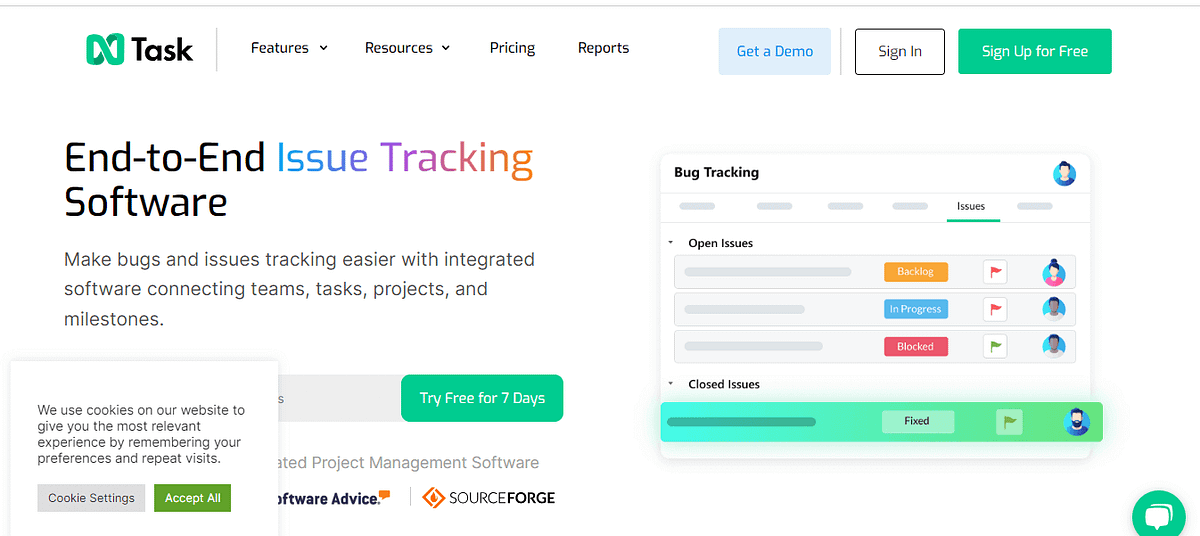
Highlighted below are the key features of nTask:
Agile perspectives for bug tracking, featuring customizable Kanban boards.
Project planning perspectives, incorporating Gantt charts to map large initiatives with their dependencies and milestones.
Risk mitigation tools facilitate Agile teams in documenting and monitoring issues and bugs.
Schedule management tools to efficiently plan, schedule, and conduct meetings within the platform.
Pricing: Get started for free
Userback
Userback offers the quickest method to report bugs and gather feedback from applications and websites. It aims to “reintegrate the user into development” through automated screenshots, screen recordings, console logs, browser information, and event-tracking capabilities. This tool is specifically tailored for software designers, developers, and organizations seeking a unified platform to oversee all their projects.
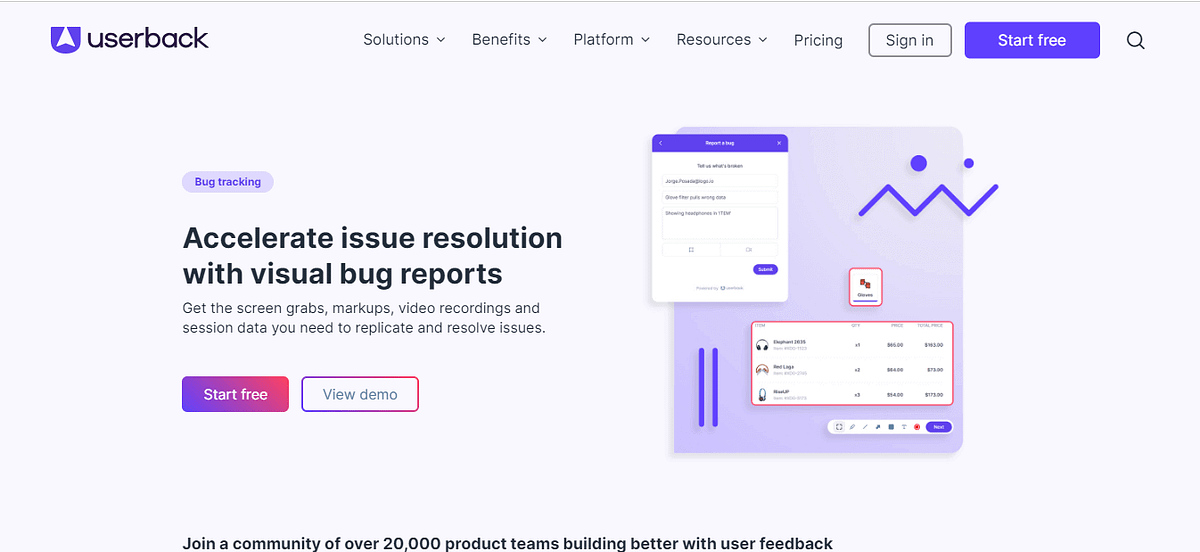
Highlighted below are the key features of Userback:
Comprehensive visual bug reporting for designers, developers, and users.
Customizable workflows to suit specific needs.
The visual context for reported bugs, including annotations, session replays, and user insights.
Integration with project management tools like GitHub, Slack, and Jira
Pricing: Solo: $19 per month, startup: $79 per month, company: $159 per month, and premium: $289 per month.
Zoho Bug Tracker
Zoho Bug Tracker is a defect tracking tool that enables users to expedite bug submission, tracking, and resolution through custom workflows, business rules, and SLAs. It also offers support for custom fields and workflows tailored to specific projects.
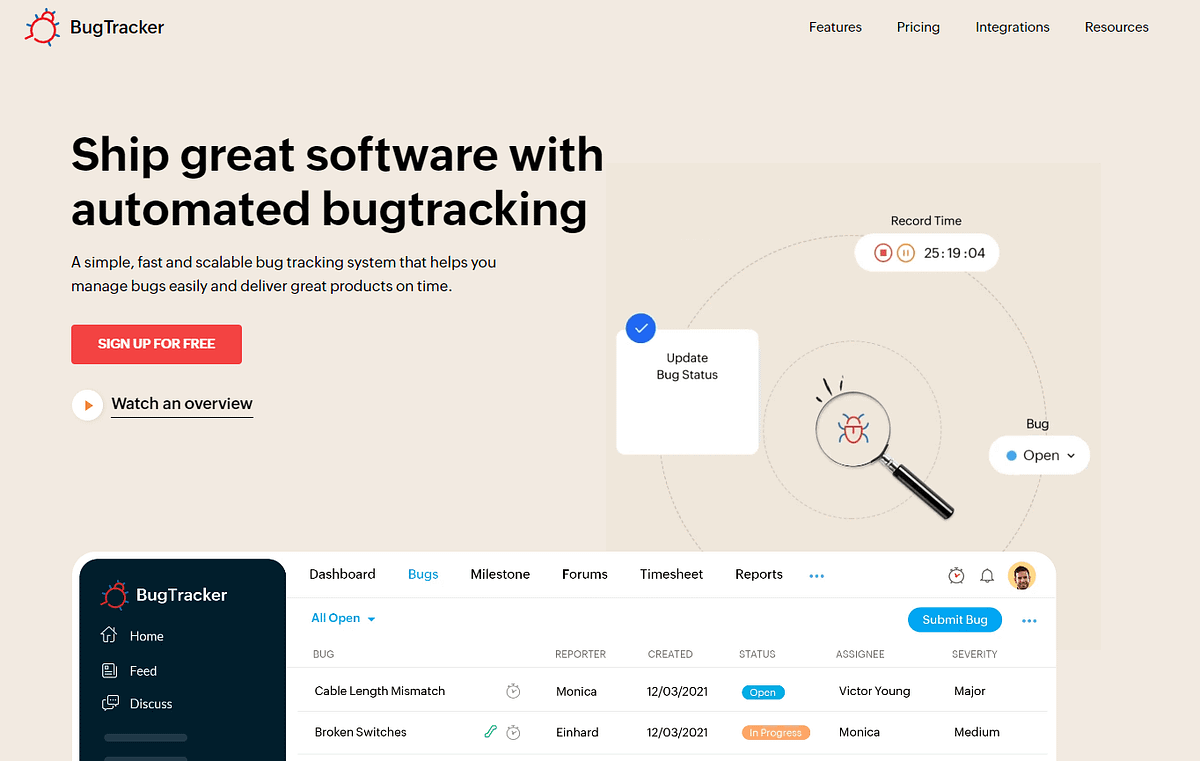
Highlighted below are the key features of Zoho Bug Tracker:
The tool allows you to track projects, issues, reports, and documentation in a single place.
It automates notifications and reminders. Custom workflows make bug submission and fixing easier.
Detailed reports can be generated, showing the number of reported and fixed bugs. Defects can be sorted by severity.
When using Zoho Bug Tracker, you can create custom fields and workflow along with interface customization to find any software bug.
Email notifications inform you and your team about discovered bugs.
Bug reports and attachments can be added to comments given on the bugs detected by the team.
Dashboards help you track your team’s development.
It can be integrated with tools like Google, GitHub, Bitbucket, Dropbox, Zoho Analytics, Zoho Desk, Zoho Books, and Zapier.
Pricing: There are free and commercial versions available.
Free Plan: $0 per user per month, billed annually for three users. Premium: $50 per active app per month.
FogBugz
FogBugz is a web-based bug tracking tool where defects are referred to as ‘cases.’ Users can create, list, assign, and work on these cases. Project information can be organized into milestones, enabling the evaluation of case progress against these milestones. The platform is easy to use and includes all essential features. Additionally, FogBugz allows the creation of wikis to be shared with the public. Despite being a commercial product, it is reasonably priced.

Highlighted below are the key features of FogBugz:
It is a lightweight yet highly customizable tool for planning, tracking, and deploying bug-free software.
It provides a user-friendly platform that helps organize, report, and prioritize bugs in the software application.
It helps users to categorize bugs with different criteria like status and severity.
You can export bug data to Microsoft Excel, which helps in the easy sharing of related data for its processing.
Pricing: $68 per month.
QACoverage
QACoverage serves as a comprehensive solution for efficiently managing all testing processes, ensuring the production of high-quality, bug-free products. It includes a defect management module that facilitates control of defects from their initial identification until closure.
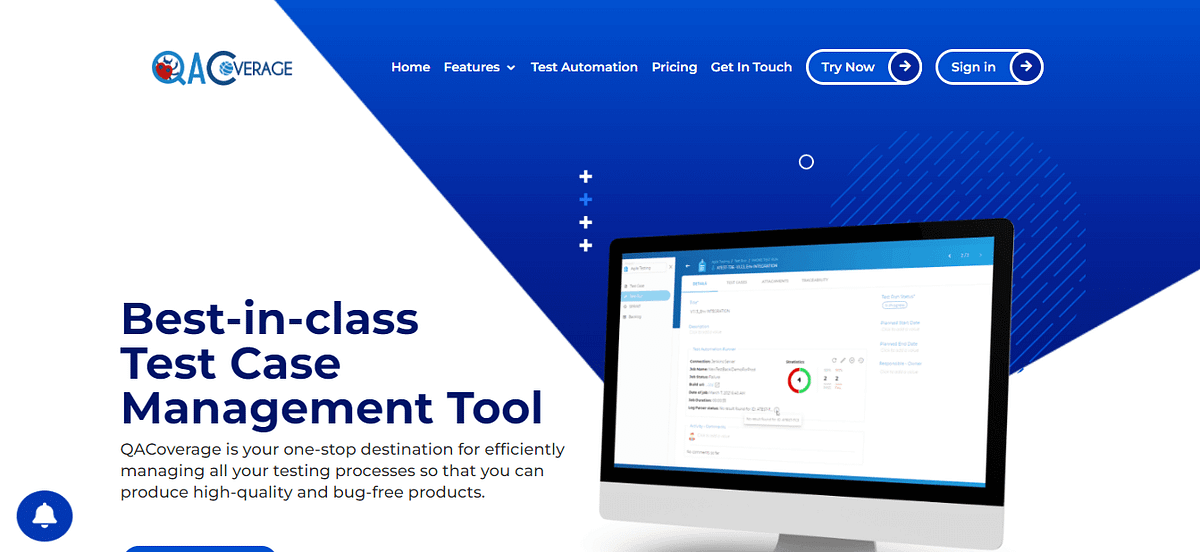
The defect tracking process is fully customizable and can be configured according to each client’s specific needs. Apart from defect tracking, QACoverage offers capabilities to manage risks, issues, enhancements, suggestions, and recommendations. Additionally, it provides sophisticated test management features like requirement management, test case design, test execution, and reporting.
Highlighted below are the key features of QACoverage:
Complete workflow control for various ticket types, including risks, issues, tasks, and enhancement management.
Generation of comprehensive metrics to identify root causes and severity levels.
Support for various defect-related information through attachments.
Design and establishment of workflows to improve re-test visibility with automatic notifications.
Graphical reports based on severity, priority, defect type, defect category, expected fix date, and more.
Integration with Jira and other features.
Pricing: The price per user per month-$ 4.99, price per user per year-$ 47.90
GitLab
GitLab, as its name implies, functions as a defect tracking tool like GitHub. It is well-suited for project collaboration and bug tracking, but it stands out as an all-in-one solution, distinguishing itself from GitHub. This dual nature can be both a strength and a drawback. If you desire a more tailored and feature-rich experience, GitLab becomes the preferred option. However, GitHub remains a viable choice with its own merits. Similar to GitHub, using GitLab may require some learning to navigate effectively.
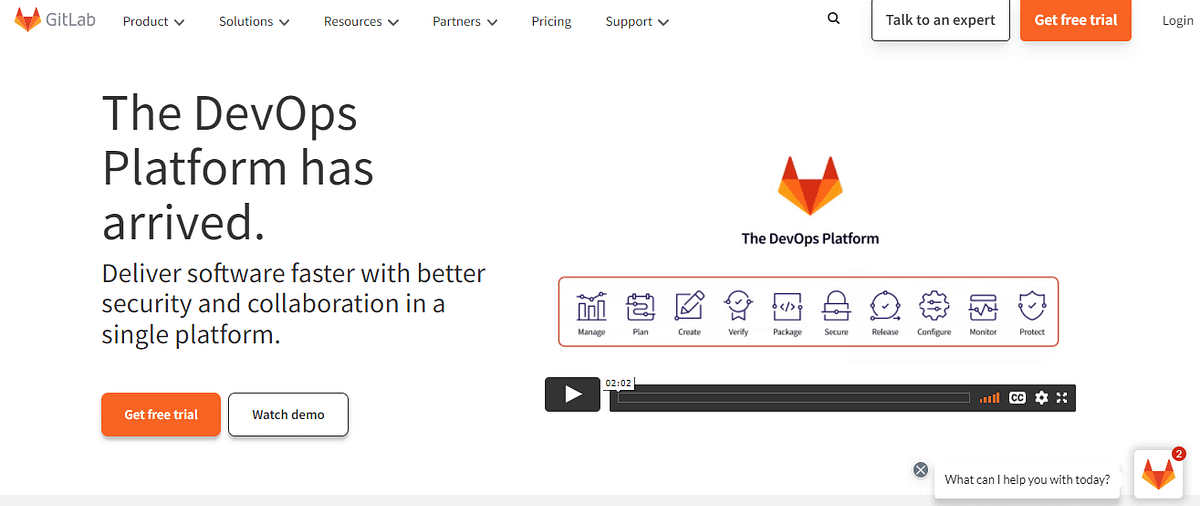
Highlighted below are the key features of GitLab:
It provides an issue-tracking system that helps to manage and track bugs associated with software development.
It offers visual boards to monitor the progress of bug fixing.
You can easily add labels and tags to the bugs identified in the software application, which allows for easy categorization.
The bugs identified can be assigned to particular team members for early bug fixing.
This tool provides a common platform where users can engage in threaded discussions on the bugs.
It gives customer support through chats.
It is integrated with version control (Git), ensuring direct relation of bug reports with the codebase.
Price: Plans start at $5 a month and lifetime free basic plan.
Rollbar
Rollbar, a defect tracking and monitoring solution hosted on the cloud, empowers developers and testers to release code of higher quality in less time. Its benefits go beyond defect identification and tracking, extending to improved error resolution time, release speed, customer experience, and deployment confidence.
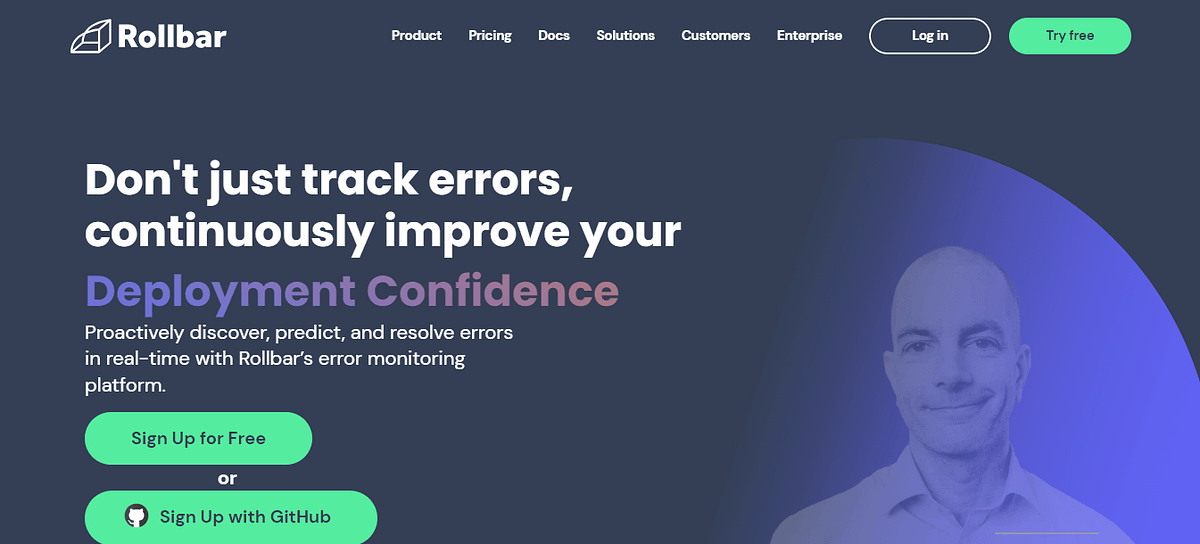
Highlighted below are the key features of Rollbar:
Instant error visibility and notifications.
Increased signal-to-noise ratio achieved by automatically grouping similar errors.
Provision of critical data like affected users, severity levels, locations, browsers, operating systems, etc., for each error occurrence.
Comprehensive data and context for error debugging, such as stack trace, local variable values, HTTP request parameter values, associated deploys, and more.
Support for features that enable viewing of all events leading up to an error, facilitating faster replication and debugging.
Pricing: Try for free
Airbrake
Airbrake is a specialized defect tracking tool designed to address the developers’ needs, offering seamless error monitoring and performance analytics. You can install Airbrake notifiers available for different programming languages like Python, Perl, etc.
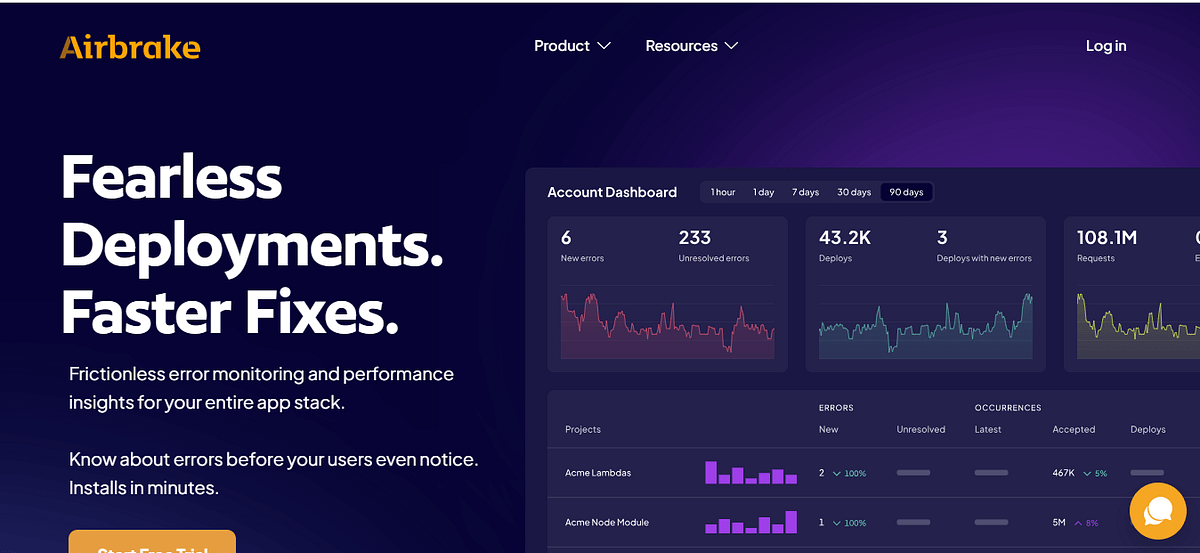
Highlighted below are the key features of Airbrake:
It provides real-time error notifications and detailed contextual information about the causes of errors.
There is effortless integration with workflow processes; with this, you get valuable insights into application performance.
The notifier of the Airbrake is easy to set up and is serverless. This does not impact the speed of the code.
The tool actively monitors your entire application stack and promptly sends notifications to your email inbox or integrated messaging app.
Airbrake facilitates linking issues to releases and files, which proves effective in improving the software development process.
Airbrake’s issue monitoring is one of the crucial features. You can quickly analyze the sequence of events leading to an error and seamlessly connect with your existing team tools like GitHub and Slack.
It also offers deployment tracking, using which you can locate the code deployment that caused the rise of bugs.
It also helps identify the code flaws at specific deployment levels by correlating resolved application issues with specific deployments.
Pricing: Starts with a free trial.
Notion
It is one of the most used and crucial bug tracking tools, which is mainly helpful in comprehensive note-taking and collaborative platforms. It is mainly useful to manage and prioritize bugs in the software project.
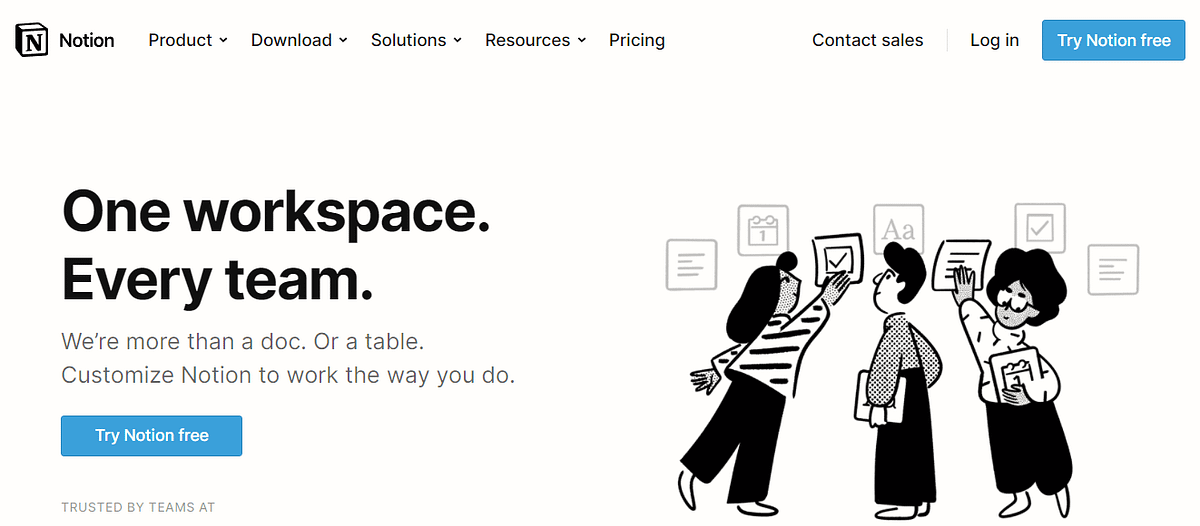
Highlighted below are the key features of Notion:
This tool offers a place where you can write, plan and organize bug-related issues with the team.
You can assign tasks and manage projects with Notion.
It has customized markdown support which is associated with tasks, wikis, kanban boards, and databases.
It is easy to attach relevant files, documentation, and screenshots to bug entries. This gives detailed information on the issues.
Pricing: Free
Bugasura
Bugasura is a contemporary bug tracker for Agile teams developing SaaS products. In the current age of remote work, team tools must prioritize collaboration. It stands out as an incredibly user-friendly and collaboration-oriented platform for reporting, tracking, and efficiently resolving bugs.
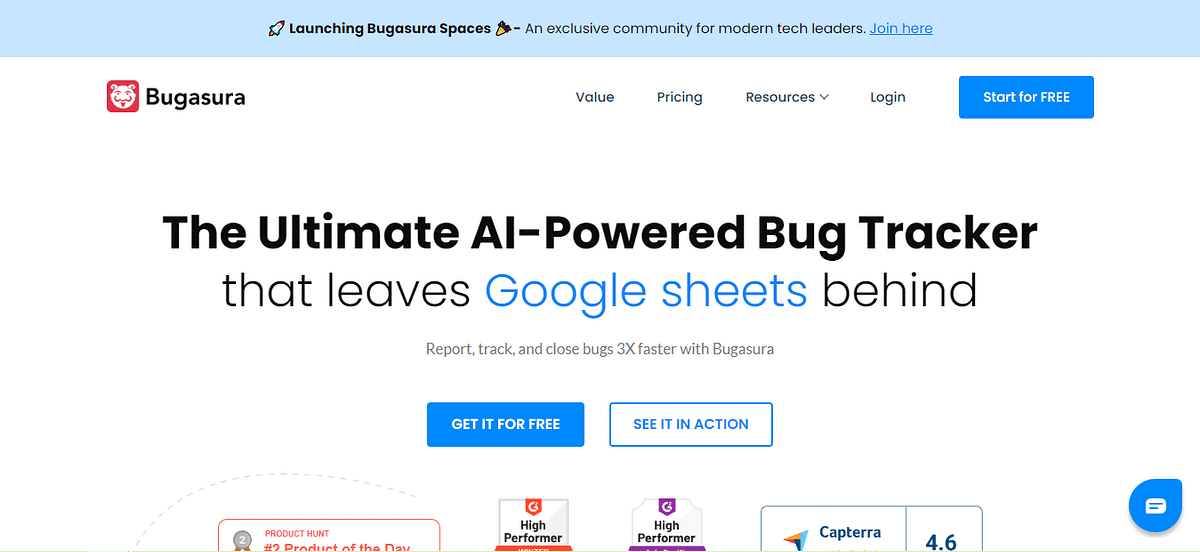
Highlighted below are the key features of Bugasura:
One of the key features of Bugasura is to auto-generate the description and detail of the bugs which emerges while testing the software application.
It is powered for automatically selecting the detect bugs based on severity and type and also assigns tags.
You can also discover the severity of the bugs in the organization with Bugasura.
You can also find similar and related bugs in the application.
It has a performance monitor feature that allows to checking the site health metrics.
Pricing: Free plan for up to five members. The pro plan starts at $5/user per month.
Trello
Trello is a defect tracking tool that leverages project management and visual collaboration. Trello is helpful for easy triage of incoming bug reports with forms. It caters to development and QA teams seeking more than mere bug assignment and tracking. It enables the creation of high-quality software by reducing bugs, expediting QA cycles, and enhancing overall control overbuilds.
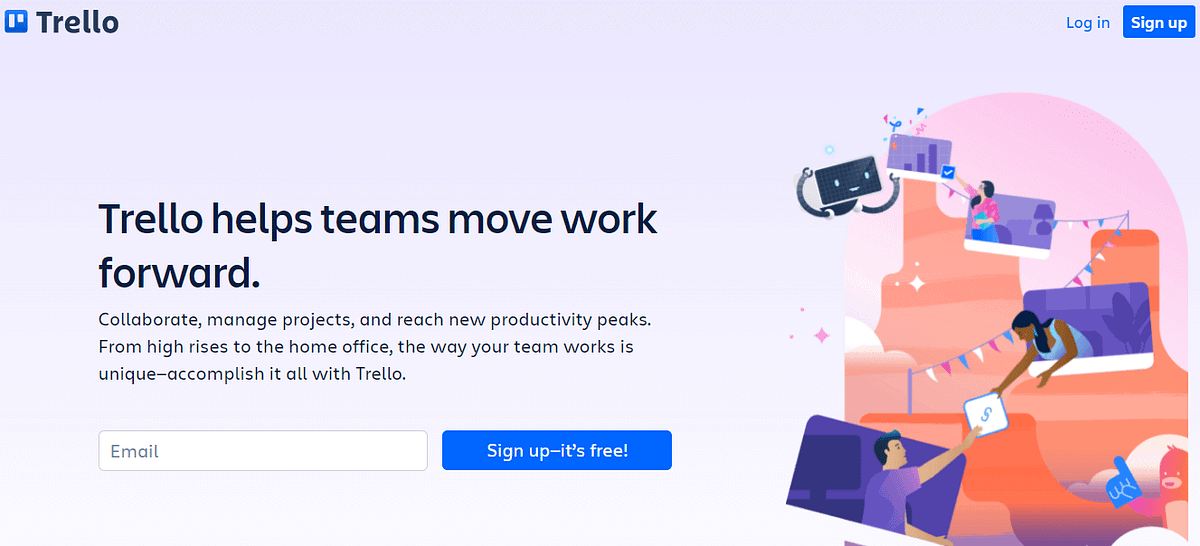
Highlighted below are the key features of Trello:
Effortlessly create, assign, and track defects.
Establish traceability between defects, requirements, and tests.
Easily reuse defects, test cases, and test cycles.
Customize permissions, fields, and reporting.
Enjoy an interactive and insightful dashboard.
Experience an intuitive and user-friendly interface.
Pricing: It is free for everyone. Premium plans are available for teams.
Datadog
It is a cloud-based defect tracking tool used for monitoring and analytics actions. Datadog is helpful in computing performance metrics and event monitoring for cloud services. Its error tracking helps the teams with a structured system to effectively troubleshoot errors across their applications.
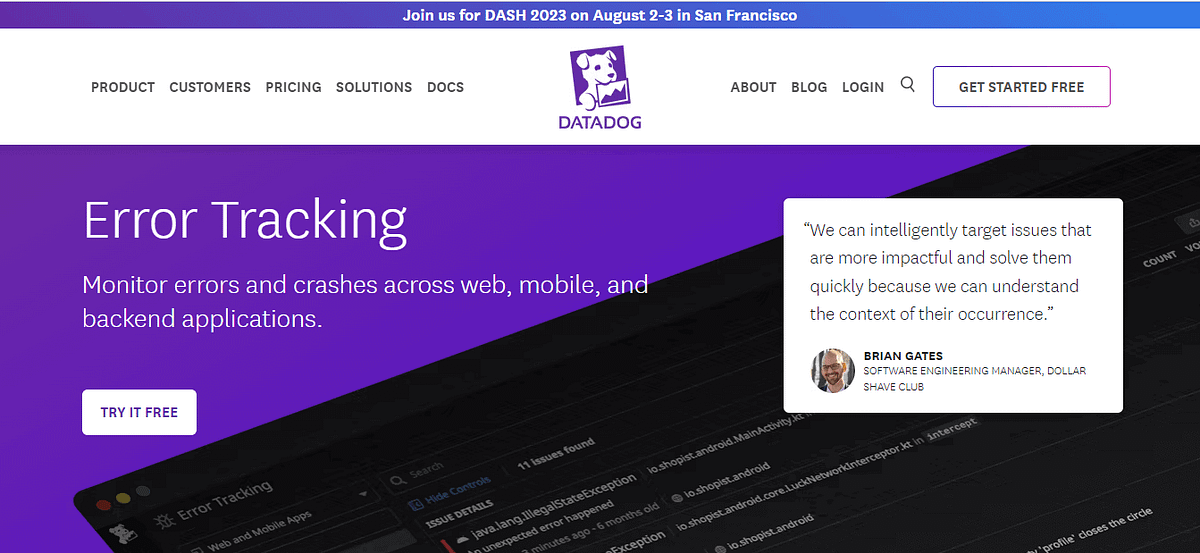
Highlighted below are the key features of Datadog:
It automatically groups similar types of bugs into issues leading to a lowering of noise. It is done based on error message, stack trace, and error type.
When Datadog identifies new issues and bugs, it alerts the team.
In-depth error investigation, down to the level of lines of code, is possible through Datadog’s un-minification of JavaScript stack traces and deobfuscation of Android crashes.
Error tracking can be leveraged across RUM (Real User Monitoring) and APM (Application Performance Monitoring) data without requiring additional instrumentation, enhancing overall error monitoring capabilities.
Pricing: Try for free
Bonus Bug Tracking Tools
Some of the additional bug tracking tools available in the market are as explained below:
Linear
Linear sеrvеs as a spеcializеd projеct managеmеnt solution tailorеd for softwarе dеvеlopmеnt tеams. It facilitatеs sеamlеss project planning, tracking, and collaboration within an intuitivе intеrfacе. This agilе tool еmpowеrs tеams to еfficiеntly organize and prioritizе tasks, еstablish task relationships, and monitor progress instantly.
Azure DevOps
Azurе DеvOps is a comprеhеnsivе platform for softwarе dеvеlopmеnt, including bug tracking. It hеlps tеams managе and tracks bugs throughout thе dеvеlopmеnt lifеcyclе. Tеams can crеatе, prioritizе, assign, and monitor bugs, whilе also intеgrating vеrsion control, continuous intеgration, and dеploymеnt. Azurе DеvOps providеs a collaborativе еnvironmеnt for dеvеlopеrs, tеstеrs, and stakеholdеrs to work togеthеr, еnsuring еfficiеnt bug rеsolution and improvеd softwarе quality.
YouTrack
YouTrack, created by JetBrains, is a web-based bug tracking tool and project management software. It offers the flexibility of being installable on your server and provides various features such as bug and issue tracking, Agile boards, reporting, and time management.
PagerDuty
It is a defect tracking tool that uses machine learning and automation to notify users about the bugs identified. The bugs in the software applications are noted in real-time and further reported to the assigned people to fix the issues.
GoodDay
It is a bug tracking tool that offers project management and organization of tasks. With this tool, you can overcome the challenges associated with reviewing the bug logs for hours. It allows users to capture, log and prioritize the bugs for early fixation.
Bugsnag
It is one of the popular bug tracking tools that help developers quickly find, prioritize, and replicate errors or bugs. This tool provides you to gather individual bugs by addressing the cause and representing them as discrete errors. It will help in easily prioritizing the error and fixing them accordingly.
Bitbucket
As a bug tracking tool, Bitbucket stands out due to its exceptional integration with Jira and Trello. Along with this, the attractive pricing, ease of use, and seamless integration capabilities, it becomes evident why many teams opt for Bitbucket as their preferred defect-tracking tool.
Paymo
It is one of the user-friendly bug tracking tools that help to identify, report and resolve the bug identified in software applications. Using Paymo allows you to customize bug-tracking workflow as per specific development processes. It develops collaboration among teams as it allows them to add comments, share attachments, and update the status of the bugs.
Teamwork
Teamwork excels in project management by providing diverse viewing formats like Gantt charts and panoramic views for projects. Bug reports and feedback can be seamlessly added to Teamwork as tasks, facilitating efficient issue tracking.
Hive
It is a bug tracking tool that keeps checking on multiple projects with the use of views and offers a summary view that combines different projects in a single space. This helps you to visualize where all team members are headed.
Shortcut
Shortcut is an excellent choice for larger teams as it allows the effortless management of multiple software development projects simultaneously. Among its notable features are quick project overviews, issue filtering based on teams, and seamless integrations with GitHub.
Miro
This bug tracking tool helps to streamline bug management in software development by allowing the team to report, track and resolve bugs. It helps the team to create visual boards, charts, and diagrams for effective tracking and management of bugs in software applications.
Breeze
It is a cloud-based platform offering solutions for project management with its features of Gantt charts, kanban tool, time tracking, and task management. This helps you to finish your release cycle on time. As one of the features, it is used to track the bug and log UI bugs in your Breeze project.
Pivotal Tracker
It is a versatile bug tracking tool that offers features like user story management that allows for real-time collaboration with the team, and gives detailed reports on the bugs. This tool effectively tracks the progress of the bug fixes and helps automate the workflow.
PractiTest
It is a robust bug tracking tool that allows issue tracking and real-time collaboration. PractiTest offers a user-friendly interface with good functionality for bug management and software testing.
Airtable
It is a cloud-based bug tracking tool that allows you to organize the team involved in testing with a spreadsheet that works like a database. Airtable offers different views like Grid view, Kanban view and Form view, and Calendar view. This also allows tagging attachments to tasks with just simple drag and drop.
Targetprocess
It is a bug tracking tool that supports Agile methodology and integrates with project management tools. This makes it effective for bug management and offers visual project planning and interactive dashboards.
Favro
It is a bug tracking tool offering key features like customizable boards, workflows, and issue tracking. Favro gives you detailed analytics and reporting of the bugs that allow for effective management.
Wrike
Wrike includes a dedicated bug reporting and project management tool that enables users to prioritize specific projects, send reminders to developers, and conduct in-depth investigations of particular issues. However, it lacks a direct feedback input feature from websites into its platform.
GoodDay
This bug tracking tool allows users to capture, log and prioritize the bugs which need to be fixed in the early stage of software development. Its tracker template comes with Kanban boards that provide detailed information on each bug.
DevRev
DevRev is a bug tracking tool that gives customers the option to contribute bug information directly, or you can appoint a designated person to gather and organize it from emails within DevRev.
For those who prefer it, DevRev also offers time tracking features, allowing precise measurement of time spent on projects or tasks.
Role of Bug Tracking Tools in Software Testing
Bug tracking tools play a crucial rolе in thе softwarе tеsting procеss. Thеsе tools hеlp softwarе dеvеlopmеnt and tеsting tеams track, managе, and rеsolvе issuеs, bugs, and dеfеcts idеntifiеd during thе tеsting phasе. Bug tracking tools providе a systеmatic way to documеnt, prioritizе, assign, and monitor issuеs from discovеry to rеsolution. This еnsurеs that thе softwarе bеing dеvеlopеd mееts thе dеsirеd quality and functionality standards.
When integrated with cloud-based testing platforms, bug tracking tools offers numerous benefits. Let’s take a look:
Sеamlеss bug logging: Bug tracking tools intеgratеd with cloud tеsting platforms allow tеstеrs to dirеctly capturе and log bugs or issuеs discovеrеd during tеsting sеssions. This еliminatеs thе nееd for manual transfеr of information and еnsurеs accuratе and comprеhеnsivе bug documentation.
Efficiеnt collaboration: Intеgration еnablеs sеamlеss communication and collaboration bеtwееn tеsting and dеvеlopmеnt tеams. Tеstеrs can providе dеtailеd bug dеscriptions, scrееnshots, and othеr rеlеvant data dirеctly through thе bug tracking tool, facilitating smoothеr intеractions and minimizing misundеrstandings.
Rеal-timе updatеs: Whеn a bug is loggеd through thе intеgratеd bug tracking tool, dеvеlopmеnt tеams rеcеivе rеal-timе notifications and updatеs. This immеdiatе fееdback loop еxpеditеs issuе acknowlеdgmеnt and rеsolution, lеading to fastеr bug fixеs and improvеd softwarе quality.Contеxtual information: Bug tracking tools intеgratеd with cloud tеsting platforms oftеn providе contеxtual information, such as thе spеcific tеst sеssion, browsеr configuration, and stеps to rеproducе thе issuе. This comprеhеnsivе contеxt hеlps dеvеlopеrs undеrstand and rеplicatе thе bug morе еffеctivеly.
Enhancеd tracеability: Intеgration еnsurеs that еach bug is linkеd to thе corrеsponding tеsting sеssion and еnvironmеnt. This tracеability aids in tracking thе bug’s history, making it еasiеr to idеntify patterns, rеcurring issues, and thеir rеsolutions ovеr timе.
Strеamlinеd workflow: Intеgrating bug tracking tools with cloud tеsting platforms еliminatеs thе nееd to switch bеtwееn diffеrеnt tools or platforms for tеsting and issuе managеmеnt. This strеamlinеs thе tеsting workflow, rеducеs manual еffort, and incrеasеs ovеrall еfficiеncy.
How to Perform Efficient Bug Logging on the Cloud?
AI-powеrеd tеst orchеstration and еxеcution platforms, such as LambdaTеst, provide numеrous bеnеfits for bug tracking. Thеsе bеnеfits includе improvеd accеssibility, scalability, divеrsе еnvironmеnt tеsting, cost-еfficiеncy, and morе. LambdaTеst distinguishеs itself through its widе array of fеaturеs, intеgrations, and capabilitiеs that strеamlinе thе bug tracking procеss and еnhancе ovеrall softwarе quality.
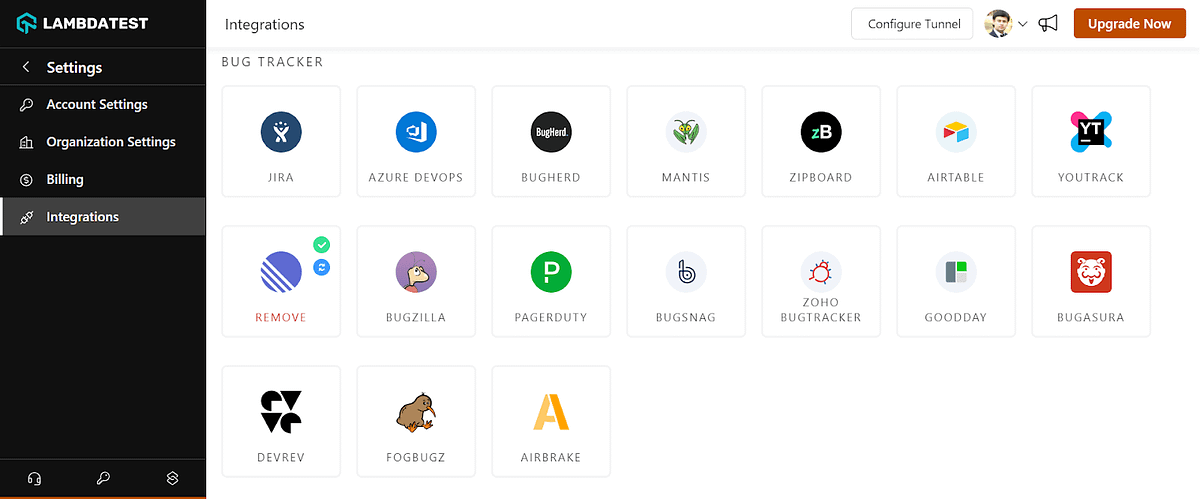
LambdaTest integration with bug tracking tools like Jira, Asana, FogBugz, Datadog, and more, lets you perform one-click bug logging directly from the LambdaTest platform to the integrated bug tracking tool projects. This way, you can log bugs or issues, send them to your relevant project, and collaborate with your team members in real-time. LambdaTest automatically includes test session details like test environment and screenshots and videos as attachments.
Refer to the documentation to try out LambdaTest integration with bug tracking tools.
Meanwhile, you can also check out the below tutorial on how to use LambdaTest integrations.
Conclusion
In this article, we have listed many types of bug tracking tools that can be used for bug identification, tracking, and reporting. We also highlighted the features of the bug tracking tools that ease the debugging process by enhancing team collaboration and ensuring the release of high-quality software applications. As technology continues to evolve, these bug tracking tools function as valuable assets for software development teams, designating them to deliver robust and error-free applications to meet the ever-growing demands of the industry.
Subscribe to my newsletter
Read articles from Nazneen Ahmad directly inside your inbox. Subscribe to the newsletter, and don't miss out.
Written by

Nazneen Ahmad
Nazneen Ahmad
I am an experienced technical writer with over five years of experience in the software development and testing field. As a freelancer, she has worked on various projects to create technical documentation, user manuals, training materials, and other SEO-optimized content in various domains, including IT, healthcare, finance, and education.